韓国人固有の遺伝子変異の圧倒的大部分はヒトの精神に関連していることは明白である
要 旨
1.2014年事実上はアメリカ政府食品医薬品局(FDA)が執筆した朝鮮人を対象として分析した集団遺伝学論文の付属資料にて、地理的に近い日本人、北方系中国人が有さず、朝鮮人のみが有する固有の遺伝子変異 が生じている遺伝子リストがエクセルファイル形式で公表されています。記事筆者が、長時間かけて、個別に手作業で調べたところ、朝鮮人固有の遺伝子変異のほぼ全てが、 何んらかの精神疾患(うつ病等)・パーソナリティー障害(間欠性爆発障害)などの 疾患感受性遺伝子であり、一言で言えば、ヒトの精神に関連する遺伝子変異でした。
2.The National Center for Biotechnology Information=アメリカ国立生物工学情報センター ウェブサイトで朝鮮人固有の遺伝子変異が生じている遺伝子を調べると、多くの場合に関連部位として 脳(brain) が表示されます。従って、1の精神疾患だけではなく、脳神経変性疾患に関しても韓国人は恐らくは極めて特異であろうという結論とならざるをえません。
注1
1.脳関連疾病は、現在の医療技術により画像その他で判明しうる脳神経変性疾患(アルツハイマー病等)と脳神経に異常を発見しえない精神疾患(統合失調症等)に大別しうる。
しかし、朝鮮人が大量に朝鮮人固有の変異を有しているCSMD1遺伝子変異に起因する統合失調症に関してpaper[179]他の論文が発表され、CSMD1遺伝子と統合失調症発症メカニズムが解明されつつある。
2.提唱されている「脳シナプスの過剰刈込説」とも言うべき仮説とノックアウトマウス実験等々が正しいのであれば、CSMD1遺伝子変異に起因する統合失調症は、現在の医療技術では絶対に発見不可能な脳神経変性疾患(=脳シナプス減少)だということになる(CSMD1遺伝子限定)
1.脳関連疾病は、現在の医療技術により画像その他で判明しうる脳神経変性疾患(アルツハイマー病等)と脳神経に異常を発見しえない精神疾患(統合失調症等)に大別しうる。
しかし、朝鮮人が大量に朝鮮人固有の変異を有しているCSMD1遺伝子変異に起因する統合失調症に関してpaper[179]他の論文が発表され、CSMD1遺伝子と統合失調症発症メカニズムが解明されつつある。
2.提唱されている「脳シナプスの過剰刈込説」とも言うべき仮説とノックアウトマウス実験等々が正しいのであれば、CSMD1遺伝子変異に起因する統合失調症は、現在の医療技術では絶対に発見不可能な脳神経変性疾患(=脳シナプス減少)だということになる(CSMD1遺伝子限定)
イントロダクション
韓国は、金大中氏がノーベル平和賞を受賞した以外にはノーベル賞受賞者ゼロであることは良く知られています。しかし、記事筆者が、2018年に調べたところ、ノーベル賞はいうまでもなく、 ガウス賞(数学)、ボルツマン賞(物理学)、ロベルト・コッホ賞(医学)等々全63もの国際的に有名な自然科学関連賞について、韓国には受賞者がただの一人もいないことを発見しました。 そのデータ詳細は、このページ最下部に表示していますこの疑いようもない客観的事実は、記事筆者をして、朝鮮人(注①)は、日本人・中国人とは異なり精神面でかなり特異な人々ではなかろうか?との疑念を生じせしめ、(注②)朝鮮人DNAに関する集団遺伝学論文を調べるきっかけとなりました。 そして、韓国人集団遺伝学者が引用したがらない下記のアメリカ政府食品医薬品局(FDA)が執筆した論文を見つけ出しました。 英文を読める方は、methods以外の部分を是非ご自身で直接読まれることを心よりお願い申し上げます。(論文であり、機械翻訳では読めません。とにかくご自分で読まれることがなによりも重要です。それで「彼らの本質」が分かります)
Whole genome sequencing of 35 individuals provides insights into the genetic architecture of Korean population
注2
韓国では、朝鮮半島とは呼ばずに「韓半島」と呼び、北朝鮮とは呼ばずに「北韓」と呼びます。 逆に、北朝鮮では、韓国と呼ばずに「南朝鮮」と呼びます。このように、朝鮮人という呼称は何ら差別用語ではありません。ただし、発音する際に、普通の日本人がするように「鮮」にアクセントを置いて発音すると 侮蔑的発音となります。朝鮮総連関係者及び朝鮮総連支持者は、必ず「朝」にアクセントを置いて発音します
注②
西欧人から見た場合、李氏朝鮮時代の朝鮮人は、日本人・中国人とは完全に異なるかなり奇異な人々であるように見えたようです。
「朝鮮幽囚記」 ヘンドリック・ハメル
p38 奴隷の数は全国民の半数以上に達します。というのは自由民と奴隷、或いは自由民の夫人と奴隷との間に一人又は多数人の子供が生まれた場合、その子供たちは全部奴隷と見なされるからです。奴隷と奴隷との間に生まれた子供は女奴隷の主人に帰属します
p42 男性は夫人を非常に好み、更にその上に非常に嫉妬深いので、たとえ親友であっても妻や娘に会うことは許されません。
p52 彼らは盗みをしたり、嘘をついたり、騙したりする強い傾向があります。彼らをあまり信用してはなりません。他人に損害を与えることは彼らにとって名誉と考えられ、恥辱とは考えられていません。
「朝鮮事情」 C・ダレ
第12章 国民性
P263 この同胞に対する交誼の感情は、親族や組合の限界をはるかに超えて拡大される。相互扶助と全ての人に対する気前の良いもてなしは、この国の国民性の顕著な特徴であり、すぐれた美点である。
P267~268 朝鮮人は、男女とも、生まれつき非常に熱情的である。しかし、真の愛情はこの国には全く存在しない。彼らの熱情は純粋に肉体的なものであって、そこのは何ら真心がない。 彼らは自分自身を満足させるため、手の届く対象にはなんにでも飛びつくあの動物的な欲望、獣的本能以外は知らない。従って、風紀の腐敗は想像を絶し、「人々の過半数は、自分たちの真の両親を知らない」と大胆に断言さえできる
P269 成長した後は、男も女も見境のないほどの怒りを絶え間なく爆発させるようになる
P275~276 黄海道の人々は、狭量で、視野の狭い性格として知られている。彼らは欲深く、信義がないと非難されている。 京畿道つまりソウルの人間は、軽薄で、節操がなく奢侈と快楽にふける。全国の典型をなすのは、この道の人たちである。朝鮮人の野心、強欲、軽薄で、節操がなく、奢侈と快楽にふける。全国の典型をなすのはこの道の人たちである。朝鮮人の野心、強欲、浪費、奢侈等われわれが前述した性格に特にあてはまるのは彼らである。この道には、大官や両班、学者たちが過度なくらい多い。
第15章 科学
朝鮮人は科学研究の分野においてはほとんど進歩の跡を見せていないが、産業の知識においては、なおさら遅れている。この国では、数世紀もの間、有用な技術は全く進歩していない。この立ち遅れの主な原因の一つに、人々が全ての手工業を各自の家でまかなわなければならないという現実がある。
「朝鮮紀行」イザベラ・バード・ビショプ
P11~12 手工業は不振である。(略)美術工芸は何もない
P166 長安寺から元山にいたる陸路の旅の間には、漢江流域を旅した時よりも朝鮮人の農耕法を見る機会に恵まれた、 日本人の細かなところにも目のいく几帳面さや清国人の 手の込んだ倹約ぶりに比べると、朝鮮人の農業はある程度無駄が多く、しまりがない。
P357 旅行者は朝鮮人が怠惰であるのに驚くが、私はロシア領満州に売る朝鮮人のエネルギーと勤勉さ、堅実さ、そして快適な家具や設備をそろえた彼らの住まいを見て以来、 朝鮮人の怠け癖を気質とみなすのは大いに疑問だと考えている
P361 朝鮮の下層階級の女性は粗野で礼儀を知らず、日本の同じ階層の女性のしとやかさや清国の農婦の節度や親切心からはおよそ程遠い。 着ているものは汚れ放題で、夜遅くまで休みなく洗濯するのは自分たちでも、綺麗ない服を着るのは男の専売特許と言わんばかりである
P363 女の子は極貧層でも見事に隠れており、朝鮮をある程度広く旅行した私でも、6歳以上と思しき少女には、女性の住まいでもものうげにうろうろしている少女たちを除き、一人も出会ったことがない
P406 朝鮮の教育はこれまで愛国者や思想家や高潔の士を輩出せずにきている。(略) 狭量、マンネリズム、慢心、尊大、 手仕事を蔑視する誤ったプライド、 寛容な公共心や社会的信頼を破壊する自己中心の個人主義、2000年前からの慣習と伝統に隷属した思考と行動、知識に関する視野の狭さ、浅薄な倫理観、女性蔑視と言ったものは朝鮮の教育制度の産物 と思われる
ビショプ夫人は、「教育制度の産物」と見做していますが、記事筆者は明らかに朝鮮人DNAの産物であると考えます。その明確な証拠こそが、上記FDA論文です。下記の結果をご覧ください
韓国では、朝鮮半島とは呼ばずに「韓半島」と呼び、北朝鮮とは呼ばずに「北韓」と呼びます。 逆に、北朝鮮では、韓国と呼ばずに「南朝鮮」と呼びます。このように、朝鮮人という呼称は何ら差別用語ではありません。ただし、発音する際に、普通の日本人がするように「鮮」にアクセントを置いて発音すると 侮蔑的発音となります。朝鮮総連関係者及び朝鮮総連支持者は、必ず「朝」にアクセントを置いて発音します
注②
西欧人から見た場合、李氏朝鮮時代の朝鮮人は、日本人・中国人とは完全に異なるかなり奇異な人々であるように見えたようです。
「朝鮮幽囚記」 ヘンドリック・ハメル
p38 奴隷の数は全国民の半数以上に達します。というのは自由民と奴隷、或いは自由民の夫人と奴隷との間に一人又は多数人の子供が生まれた場合、その子供たちは全部奴隷と見なされるからです。奴隷と奴隷との間に生まれた子供は女奴隷の主人に帰属します
p42 男性は夫人を非常に好み、更にその上に非常に嫉妬深いので、たとえ親友であっても妻や娘に会うことは許されません。
p52 彼らは盗みをしたり、嘘をついたり、騙したりする強い傾向があります。彼らをあまり信用してはなりません。他人に損害を与えることは彼らにとって名誉と考えられ、恥辱とは考えられていません。
「朝鮮事情」 C・ダレ
第12章 国民性
P263 この同胞に対する交誼の感情は、親族や組合の限界をはるかに超えて拡大される。相互扶助と全ての人に対する気前の良いもてなしは、この国の国民性の顕著な特徴であり、すぐれた美点である。
P267~268 朝鮮人は、男女とも、生まれつき非常に熱情的である。しかし、真の愛情はこの国には全く存在しない。彼らの熱情は純粋に肉体的なものであって、そこのは何ら真心がない。 彼らは自分自身を満足させるため、手の届く対象にはなんにでも飛びつくあの動物的な欲望、獣的本能以外は知らない。従って、風紀の腐敗は想像を絶し、「人々の過半数は、自分たちの真の両親を知らない」と大胆に断言さえできる
P269 成長した後は、男も女も見境のないほどの怒りを絶え間なく爆発させるようになる
P275~276 黄海道の人々は、狭量で、視野の狭い性格として知られている。彼らは欲深く、信義がないと非難されている。 京畿道つまりソウルの人間は、軽薄で、節操がなく奢侈と快楽にふける。全国の典型をなすのは、この道の人たちである。朝鮮人の野心、強欲、軽薄で、節操がなく、奢侈と快楽にふける。全国の典型をなすのはこの道の人たちである。朝鮮人の野心、強欲、浪費、奢侈等われわれが前述した性格に特にあてはまるのは彼らである。この道には、大官や両班、学者たちが過度なくらい多い。
第15章 科学
朝鮮人は科学研究の分野においてはほとんど進歩の跡を見せていないが、産業の知識においては、なおさら遅れている。この国では、数世紀もの間、有用な技術は全く進歩していない。この立ち遅れの主な原因の一つに、人々が全ての手工業を各自の家でまかなわなければならないという現実がある。
「朝鮮紀行」イザベラ・バード・ビショプ
P11~12 手工業は不振である。(略)美術工芸は何もない
P166 長安寺から元山にいたる陸路の旅の間には、漢江流域を旅した時よりも朝鮮人の農耕法を見る機会に恵まれた、 日本人の細かなところにも目のいく几帳面さや清国人の 手の込んだ倹約ぶりに比べると、朝鮮人の農業はある程度無駄が多く、しまりがない。
P357 旅行者は朝鮮人が怠惰であるのに驚くが、私はロシア領満州に売る朝鮮人のエネルギーと勤勉さ、堅実さ、そして快適な家具や設備をそろえた彼らの住まいを見て以来、 朝鮮人の怠け癖を気質とみなすのは大いに疑問だと考えている
P361 朝鮮の下層階級の女性は粗野で礼儀を知らず、日本の同じ階層の女性のしとやかさや清国の農婦の節度や親切心からはおよそ程遠い。 着ているものは汚れ放題で、夜遅くまで休みなく洗濯するのは自分たちでも、綺麗ない服を着るのは男の専売特許と言わんばかりである
P363 女の子は極貧層でも見事に隠れており、朝鮮をある程度広く旅行した私でも、6歳以上と思しき少女には、女性の住まいでもものうげにうろうろしている少女たちを除き、一人も出会ったことがない
P406 朝鮮の教育はこれまで愛国者や思想家や高潔の士を輩出せずにきている。(略) 狭量、マンネリズム、慢心、尊大、 手仕事を蔑視する誤ったプライド、 寛容な公共心や社会的信頼を破壊する自己中心の個人主義、2000年前からの慣習と伝統に隷属した思考と行動、知識に関する視野の狭さ、浅薄な倫理観、女性蔑視と言ったものは朝鮮の教育制度の産物 と思われる
ビショプ夫人は、「教育制度の産物」と見做していますが、記事筆者は明らかに朝鮮人DNAの産物であると考えます。その明確な証拠こそが、上記FDA論文です。下記の結果をご覧ください
上記FDA論文にて、エクセル形式で朝鮮人固有の遺伝子変異が生じているリストが付属資料として公開されています
記事筆者は、上記の朝鮮人固有の遺伝子変異が生じている遺伝子について、NCBI (The National Center for Biotechnology Information )で表示されてくる論文を参照しつつ、基本的には手作業でGoogle論文検索で長時間かけて調べました。 具体的には、CSMD1(遺伝子名)+mental、CSMD1(遺伝子名)+GWAS、CSMD1(遺伝子名)+cognitive等々でグーグルの論文検索をする方法です。
注
*ゲノムワイド関連分析(GWAS)とは、遺伝統計学によるゲノムデータ解析(岡田 随象 大阪大学大学院医学系研究科教授)によれば、下記の通りです。(SNPとは、一塩基多型)
「ヒトゲノム全体を網羅する数百万〜1,000 万か所の SNPにおけるジェノタイプ分布と,対象形質との因果関係を並列に計算する解析手法がゲノムワイド関連解析である.
(略)各 SNP においては,サンプル別ジェノタイプのベクトルを独立変数,解析対象形質のベクトルを従属変数として扱い,因果関係を回帰分析により評価する. (略)ゲノムワイド関連解析は日本の理化学研究所で初めて実施された手法である。(略)シンプルな手法であるが,それ故に多数のサンプルを組み込むことが可能であり,これまでに数多くの疾患における感受性遺伝子変異の同定に貢献してきた.すでに 1,000 を超えるゲノムワイド関連解析 が,数百のヒト疾患や形質に対して実施され,成果のデータ ベ ー ス 化 も 行 わ れ て い る
*ゲノムワイド関連分析(GWAS)とは、遺伝統計学によるゲノムデータ解析(岡田 随象 大阪大学大学院医学系研究科教授)によれば、下記の通りです。(SNPとは、一塩基多型)
「ヒトゲノム全体を網羅する数百万〜1,000 万か所の SNPにおけるジェノタイプ分布と,対象形質との因果関係を並列に計算する解析手法がゲノムワイド関連解析である.
(略)各 SNP においては,サンプル別ジェノタイプのベクトルを独立変数,解析対象形質のベクトルを従属変数として扱い,因果関係を回帰分析により評価する. (略)ゲノムワイド関連解析は日本の理化学研究所で初めて実施された手法である。(略)シンプルな手法であるが,それ故に多数のサンプルを組み込むことが可能であり,これまでに数多くの疾患における感受性遺伝子変異の同定に貢献してきた.すでに 1,000 を超えるゲノムワイド関連解析 が,数百のヒト疾患や形質に対して実施され,成果のデータ ベ ー ス 化 も 行 わ れ て い る
結 果
additional_file_7.xlsx中から朝鮮人固有の遺伝子変異の数が300以上又は特筆すべき遺伝子に限定して個々の遺伝子を手作業で調べた結果が下記の通りです。(1)DNA中で韓国人固有の変異が生じている遺伝子の圧倒的大部分が、何らかの精神疾患、パーソナリティー障害の疾患感受性遺伝子候補でした。 ただし、記事筆者が調べた範囲では、統合失調症とうつ病については、韓国の生涯有病率は日本と明確な差はないように思えます。(うつ病については論文により数値が異なり、統合失調症に関してはほぼ確実に日本と同様です。)
また、韓国人の場合、現生人類だけが有しているNOTCH2NL遺伝子に代表されるようにヒトの頭脳全般(ヒトの精神面での進化)に関連する遺伝子について 変異が数量ベースで見れば明確に集中していました。
下記に掲げた遺伝子について、韓国人は、地理的に近い日本人・北方系中国人が有していない韓国人固有の、韓国人だけの変異を有しているのだという点をご理解ください。
(2)ただし、病理遺伝学論文は、Aという論文で、遺伝子名〇〇〇が疾病名〇〇〇と関連がありそうだとする病理遺伝学論文が出された後、 しばらくすると、関連性は薄いという別の論文が出されるケースが多い点にはくれぐれもご留意ください。
(3)論文名は、この記事最下部に記載しています
(4)下の表内でNCBIと略称しているのは、非常に有名な The National Center for Biotechnology Information=アメリカ国立生物工学情報センター です。
①=遺伝子名
②=FDA論文が抽出した韓国人に固有の遺伝子変異数(additional_file_7.xlsx中のSNV1)
③=知的障害、精神疾患、パーソナリティー障害等の名称
なお、paper[144] の付属資料中の遺伝子リストにより、遺伝子の長さ(単位:bp)≒遺伝子の塩基数と韓国人固有の変異数(塩基数)が比例関係にないことは確認済みです
(例)PRIM2遺伝子は、長さ4,668(bp)、5033の韓国人固有の変異、MAGI2遺伝子は、長さ31,624(bp)で506の韓国人固有の変異
スマホの場合、指で右へスクロール
| ① | ② | ③ |
|
PRIM2 DNAプライマーゼをコードしている NCBIでは、骨髄が関連部位として明確に表示される |
5033 | 不眠症 paper[86] 統合失調症 paper[103] |
CSMD1 最重要
100% 確実 SNV35=1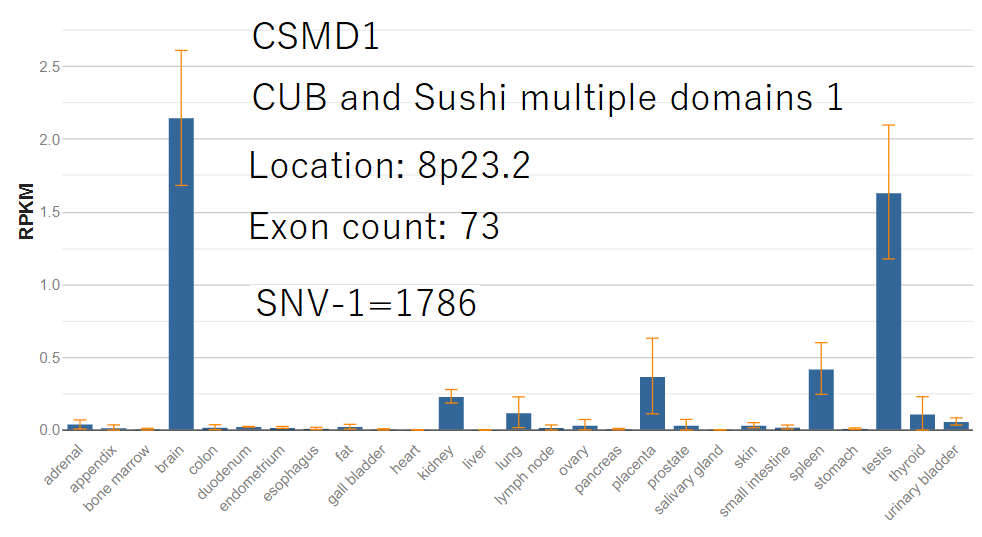 遺伝子名にSushiという奇妙な名称が含まれるのは生成されるたんぱく質の推定立体構造が下記のような握り寿司に似た奇妙な形状であるため
遺伝子名にSushiという奇妙な名称が含まれるのは生成されるたんぱく質の推定立体構造が下記のような握り寿司に似た奇妙な形状であるため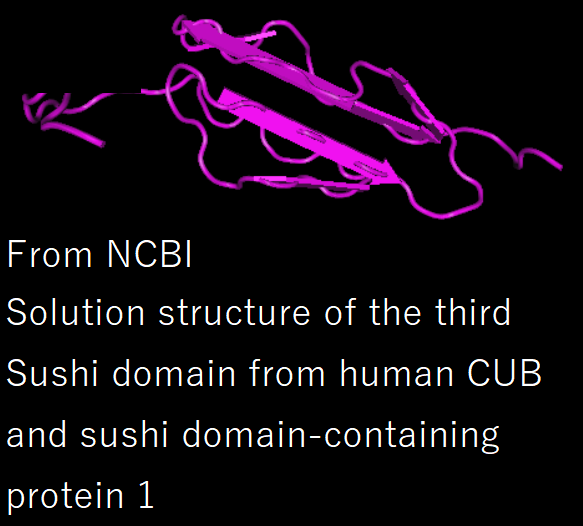 |
1786 | 統合失調症 paper[9] paper[52] paper[115] paper[116] paper[141] paper[142] paper[148] paper[165] paper[178] 170のサンプルは日本人 paper[178] paper[181] 双極性障害 paper[66] paper[148] paper[165] 健常者男性知的機能全般 rs10503253置換変異 paper[116] 抜粋メモはこのページ 自閉症 paper[137] 高齢健常者の認知能力 paper[138] 脳の扁桃体(社会的・感情的な行動)rs10105357変異 paper[139] rs10503253 ①統合失調症(患者)②健常者の場合には記憶・学習能力 paper[140] 神経発達症 (DSM-5) paper[179] |
|
snoU13 =snoRNA この遺伝子シンボル名では、NCBIでは、ヒットしない |
1731 | うつ病, 不眠症? paper[43] snoU13 1989年発見 |
|
PDE4DIP この遺伝子が統合失調症に関連するとの論文は調べた範囲では存在しない NCBIでは、心臓が関連部位として明確に表示され、脳は大きく差がある第2順位に過ぎない 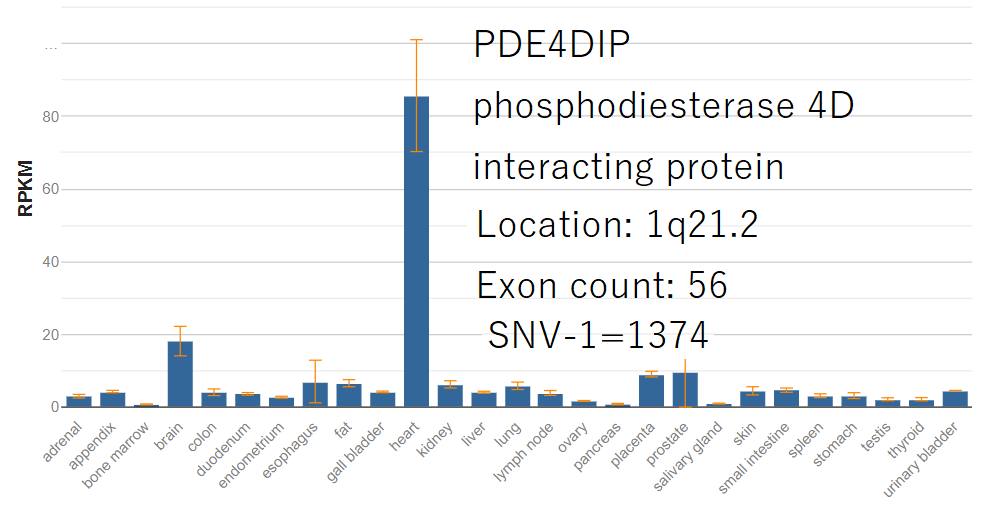 |
1374 | 精神障害全般 paper[4] paper[177] うつ病, paper[91] 認知症 paper[119] (脳の神経細胞間)シナプスへの影響 paper[173] |
|
RBFOX1 100%確実 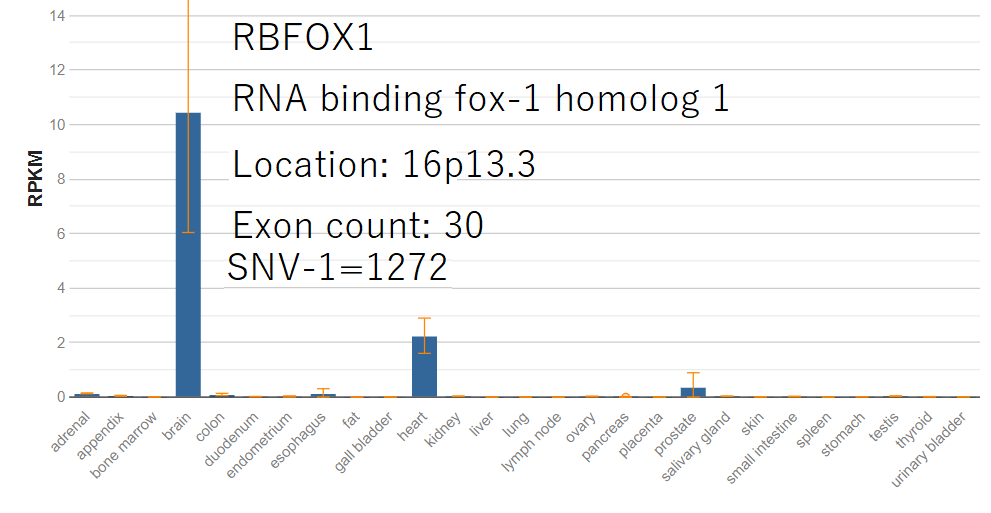 |
1272 | 知能 paper[168] 168論文はサンプル数30万以上GWAS論文 paper[169] 不眠症 paper[161] 自閉症 paper[165] 怒り、他者への攻撃性、行為障害、自閉症 paper[100] 統合失調症、精神機能全般 paper[5] paper[167] うつ病、統合失調症、神経症傾向 paper[121] パーソナリティー、アルコール依存症(攻撃性については否定) paper[122] 注意欠陥多動性障害 paper[123] paper[182] 攻撃的な行動 paper[124] 統合失調症 (the neuronspecific RNA splicing regulator) paper[125]極めて重要な抜粋メモ その他関連論文多数 |
PTPRN2 |
1224 | 間欠性爆発障害 paper[99] うつ病 paper[6] 統合失調症、注意欠陥多動性障害 paper[126] |
|
KMT2C 遺伝子名は、メチル基転移酵素をコードする遺伝子であることを示している。 NCBIでは特定の部位を全く示さない |
1091 | 知能 paper[159] 双極性障害 paper[7] paper[130] 統合失調症 paper[128] うつ病 paper[129] |
PTPRD |
1084 | 不眠症 paper[161] 知能 paper[159] paper[168] 注意欠陥多動性障害 paper[165] 双極性障害 paper[165] 強迫性障害 paper[8] paper[165] paper[127] 統合失調症 synaptic adhesion paper[125] 脳細胞の結合=シナプスの態様決定。例示的に、知的障害・不安症・強迫性障害 paper[127] 自閉症 paper[137] 強迫性障害 paper[143] Neuroticism(神経質傾向) paper[143] |
|
LINC00842 NCBIでは、明確に肌が表示され、脳との関連は全くない |
1008 |
該当なし |
CNTNAP2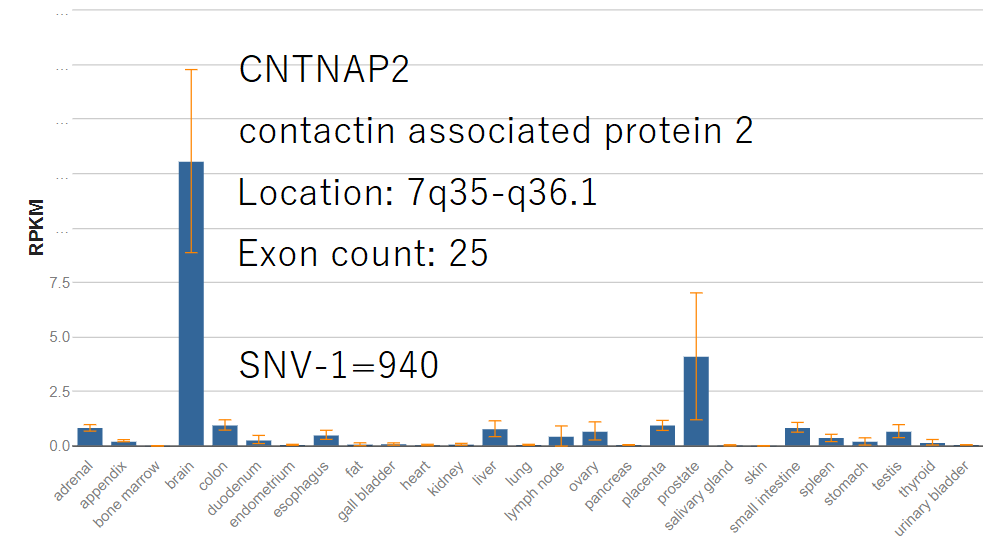 |
940 | 知的障害、自閉症 paper[109] 統合失調症 paper[10] paper[165] 精神障害全般、言語発達障害 paper[131] ヒトの精神機能全般 paper[175] 反社会性パーソナリティー障害 paper[176] |
ROBO2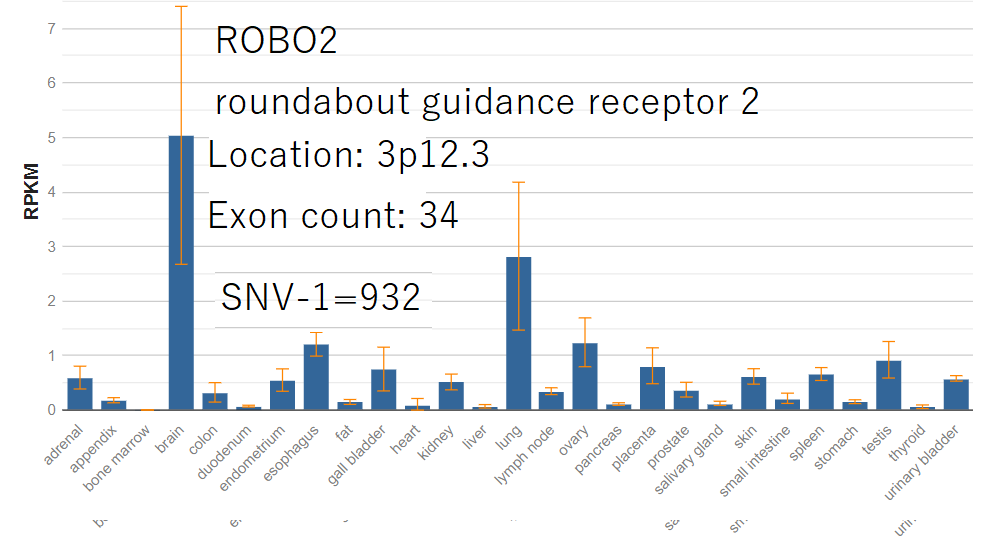 |
932 | >統合失調症 うつ病 paper [13] 自閉症 paper [117] |
|
ZNF717 遺伝子名は、訳すと、亜鉛 指 タンパク質をコードする遺伝子であることを示している。 指という変な名称は生成されるタンパク質の立体形状からの命名であろう NCBIでは特定の部位を全く示さない |
859 | 知的障害 paper[14] 精神神経症候群 paper[93] 頭脳 paper[94] 自閉症 paper[132] |
|
CROCC NCBIでは、脳との関連は表示されない |
844 | 該当なし |
|
AF146191 NCBIでは、この遺伝子シンボル名ではヒットしない |
800 | 不眠症 paper[101] |
|
LSAMP この遺伝子について、統合失調症との関連を示す論文があるはずなので調べること 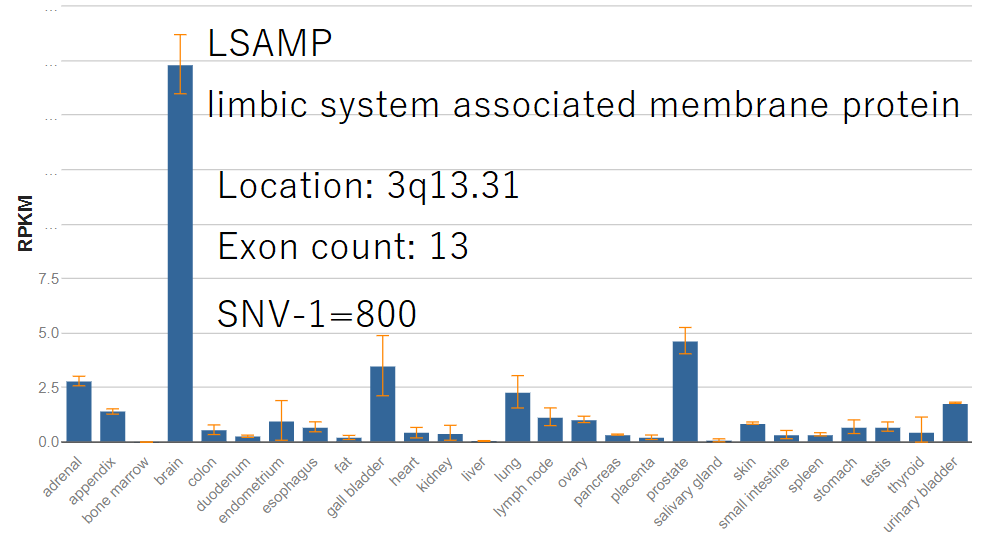 |
800 | 不眠症 paper[161] 自殺傾向 paper[15] 双極性障害 paper[165] |
|
WWOX NCBIでは、脳は第3順位に過ぎず、甲状腺が強く出ている |
797 | 精神薄弱
paper[81] 自閉症 paper[165] |
DLG2 |
789 | 統合失調症
paper[5] |
|
GUSBP1 |
760 | 該当なし |
|
EYS NCBIでは、関連部位として脳は第3順位に過ぎない |
759 | 統合失調症 paper[5] 双極性障害 paper[160] |
|
ANKRD30BL |
730 | 該当なし |
|
PCDHA1 ~ PCDHA14 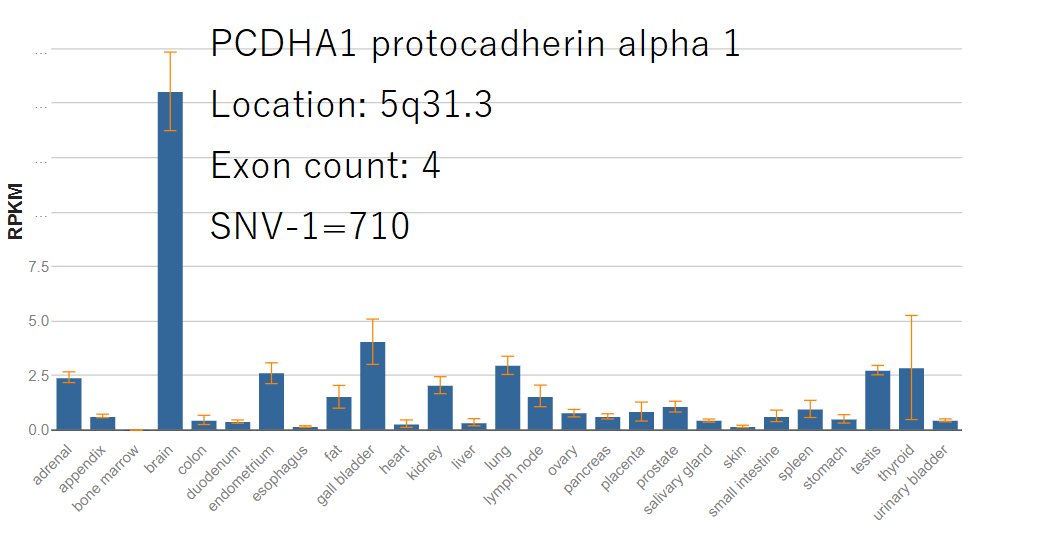 |
710 | 統合失調症 paper[166] |
MACROD2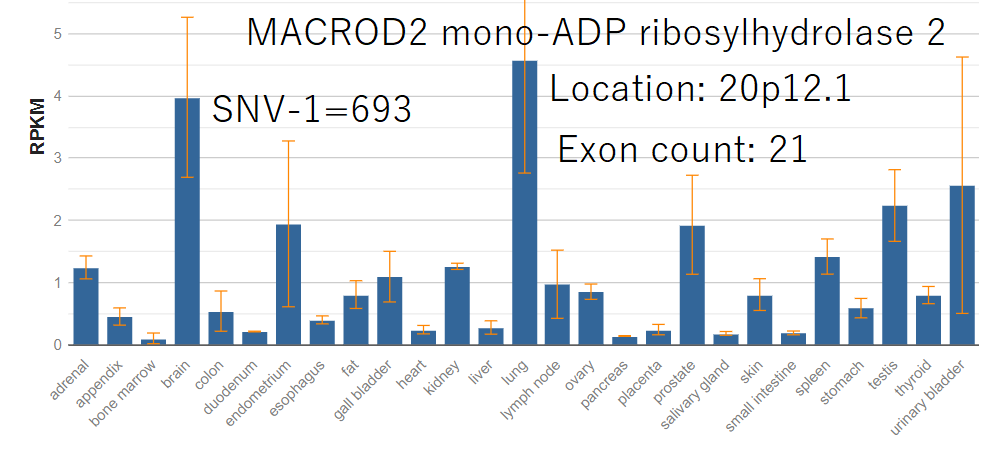 |
693 | 知能 paper[168] paper[169] 自閉症 paper[165] 双極性障害 paper[5] うつ病 paper[158] |
DPP6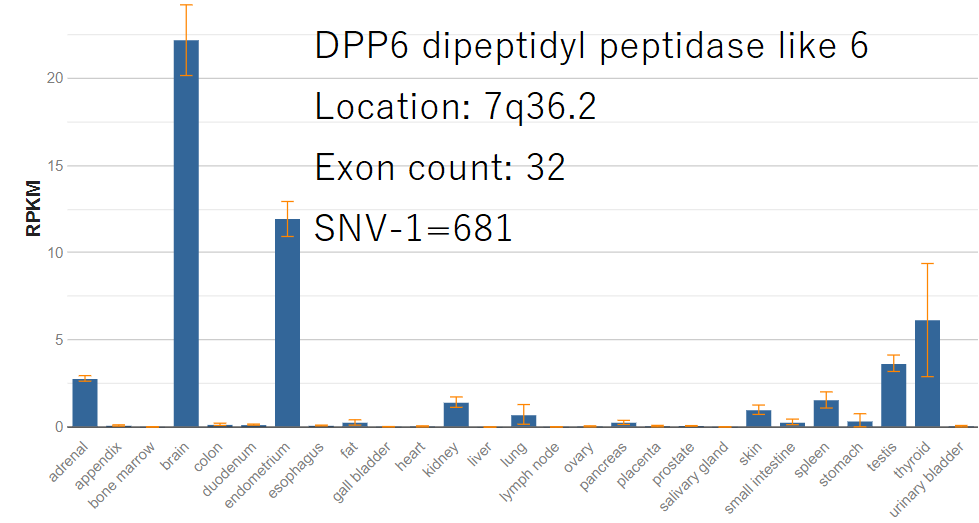 |
681 | 脳神経発達症群 paper[89] |
LRP1B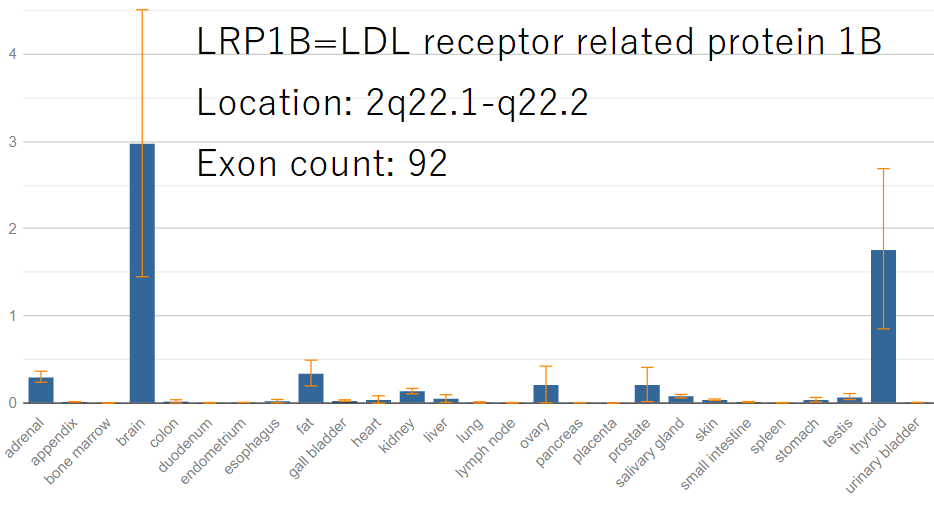 |
677 | 知能 paper[159] 認知機能 paper[5] 統合失調症 paper[165] |
|
TPTE NCBIでは、精巣のみを関連部位として示す |
664 | 知能 paper[159] うつ病リスク paper[110] |
|
ANKRD36C |
653 | 該当なし アルツハイマー病のみあり。=MRI診断=精神疾患扱いではない paper[112] |
PCDH15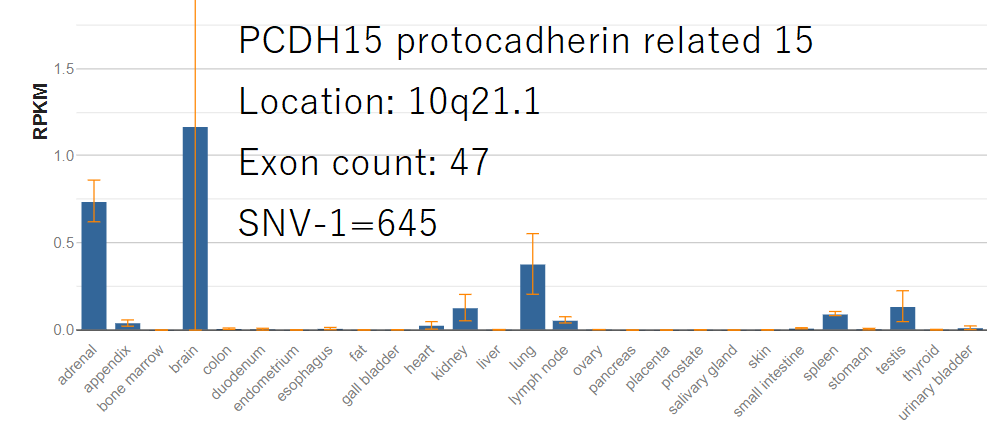 |
645 | 認知機能(知的機能) paper[114] 統合失調症・自閉症 paper[82] 注意欠陥多動性障害 paper[182] |
|
FHIT NCBIでは、脳はごく弱くしか表示されない |
642 | 統合失調症 paper[5] paper[165] |
|
LINC00969 =MIR570HGであり、NCBIでは特定の関連部位を示さない |
640 | 統合失調症
paper[57] |
|
KCNJ12 NCBIでは脳は第2順位であるが心臓が強く出ている |
626 | うつ病 paper[113] |
|
BAGE2 |
618 | 該当なし。アルツハイマー病のみあり paper[146] |
|
UPK3B |
608 | 該当なし |
|
CTNNA3 NCBI関連部位では脳は第二順位である。しかし、圧倒的な第一順位は心臓である |
605 | 統合失調症 paper[165] 自閉症 paper[79] 衝動的行動 paper[172] 抗うつ剤の有効性 paper[98] |
NRXN3 |
602 | 神経精神疾患 paper[80] 自閉症 paper[117] |
|
CDH13 NCBIの関連部位表示では脳は、第3順位に過ぎない |
600 | 自閉症・統合失調症・双極性障害・うつ病・注意欠陥多動性障害 paper[16] paper[64] 統合失調症・注意欠陥多動性障害 paper[165] 反社会性パーソナリティー障害 paper[176] |
SGCZ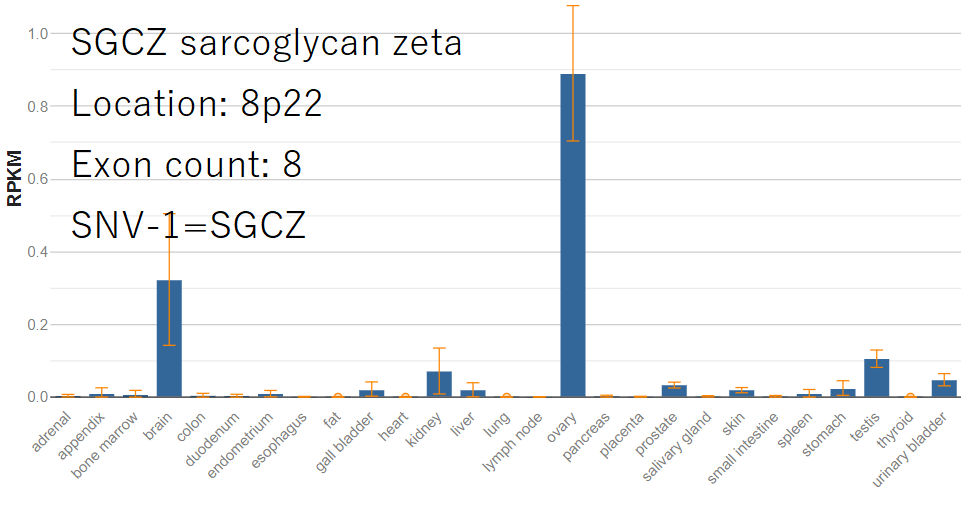 |
582 | 知能 paper[168] うつ病的傾向 paper[73] |
|
CNTN5 NCBIでは脳は関連順位第3位である |
568 | 自殺傾向 paper[74] |
|
PARK2 NCBIではこの遺伝子シンボル名では出てこない |
568 | 知能 paper[159] 知的障害・自閉症 paper[109] パーソナリティー paper[75] |
|
MAP2K3 NCBIでは脳との関連はほとんど示されていない |
564 | 精神疾患全般 paper[76] 自閉症 paper[146] |
|
CCSER1 NCBIでは脳との関連はほとんど示されていない |
564 | 該当なし、アルコール依存症 paper[77] |
GRID2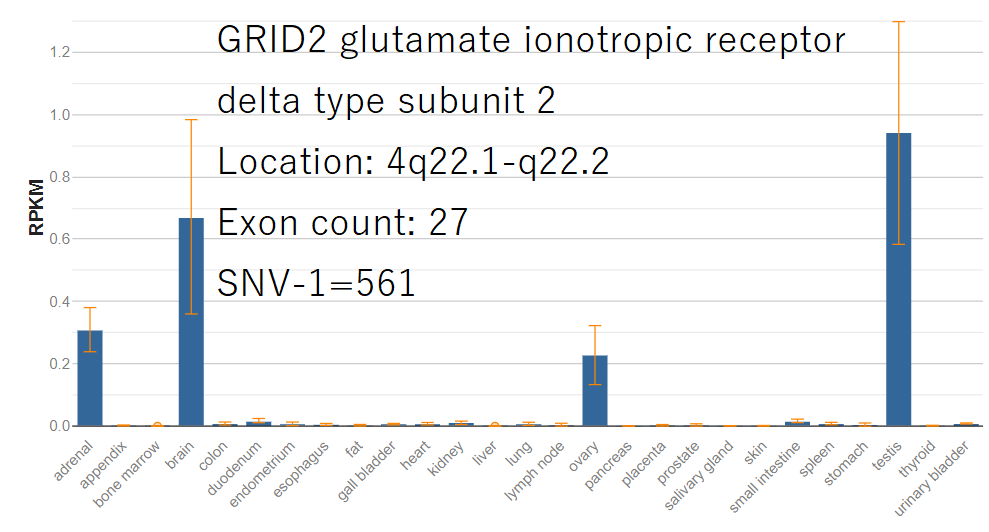 |
561 | 心的ストレス paper[78] |
CTNNA2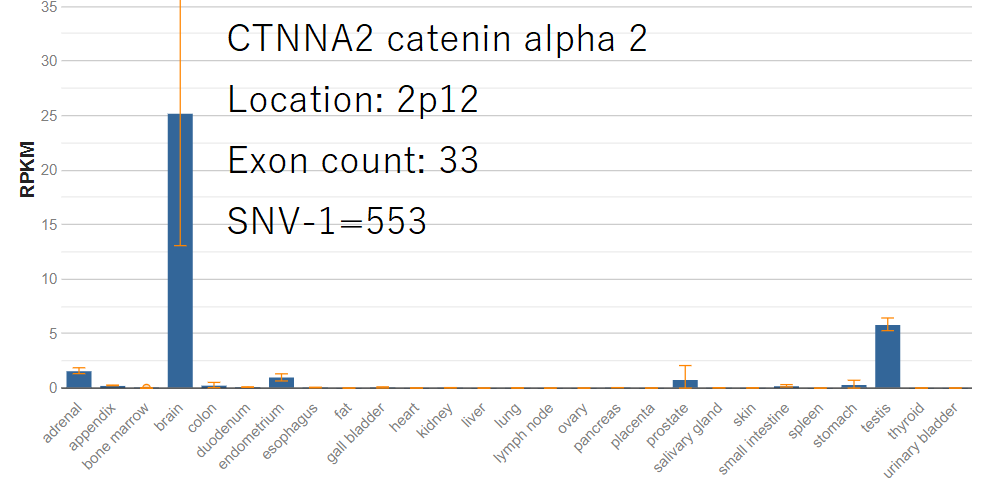 |
553 | 知能 paper[168] 教育達成度 paper[5] 衝動的行動 paper[172] |
|
DAB1 NCBIでは、脳は第3順位に過ぎない |
528 | 不眠症 paper[161] 精神薄弱 paper[44] 統合失調症 paper[165] |
GPC5 |
527 | 知能 paper[159] 認知機能 paper[45] |
|
NAALADL2 NCBIでは、脳との関連はごく弱くしか表示されない |
519 | 自閉症 paper[46] |
MAGI2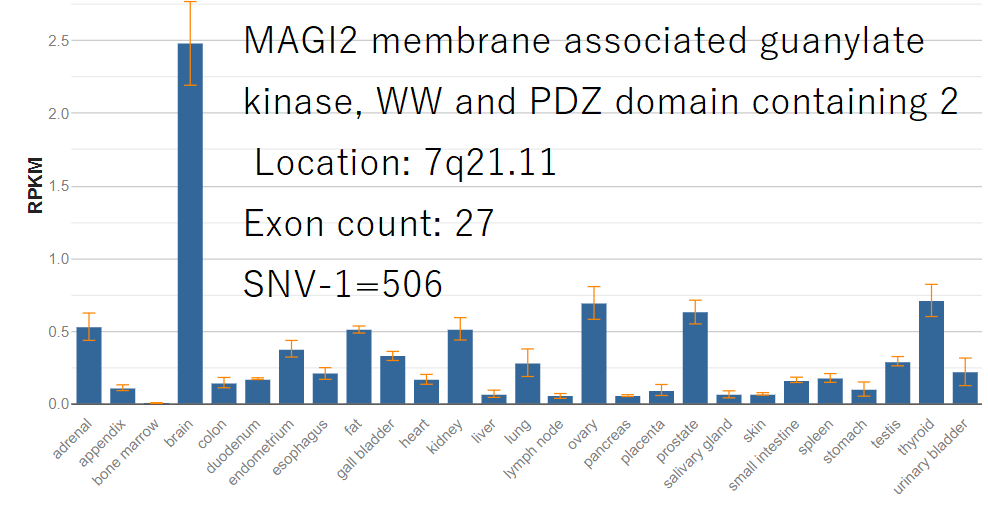 |
50MAGI26 |
統合失調症・うつ病 [paper[47] パーソナリティー [paper[75] 統合失調症、synaptic adhesion paper[125] paper[165] |
DPP10 |
505 | 神経発達障害全般 paper[177] 注意欠陥多動性障害 paper[48] |
|
PDE4D NCBI関連日表示では脳は第五順位に過ぎない |
503 | 知能 paper[168] paper[169] 強迫性障害 paper[49] (脳の神経細胞間)シナプスへの影響 paper[173] |
KCNIP4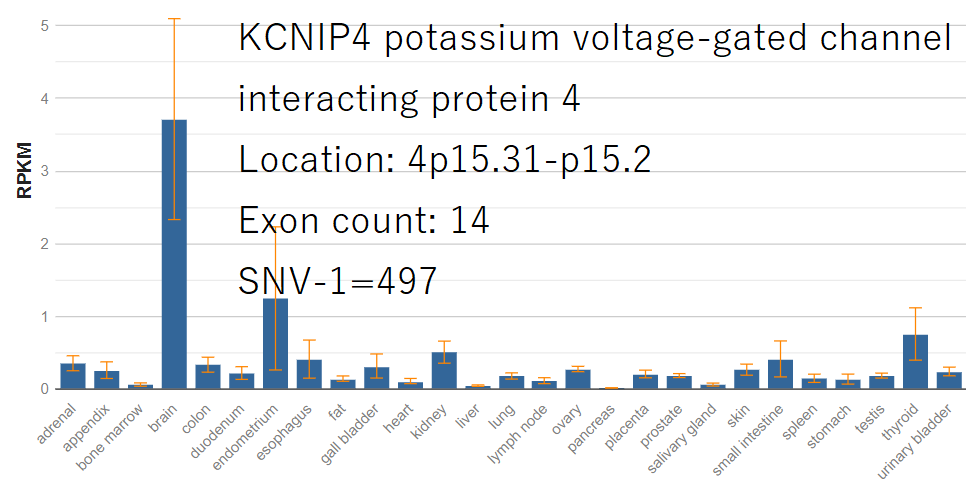 |
497 | パーソナリティー障害・注意欠陥多動性障害 paper[50] |
|
CNTN4 NCBIの関連部位表示では、子宮内膜→甲状腺→脳 である |
485 | 知的障害・自閉症 paper[109] paper[177] 統合失調症 paper[40] paper[165] 自閉症 paper[137] 双極性障害 paper[160] |
|
TBC1D5 |
478 | paper[51] 双極性障害 |
AGBL4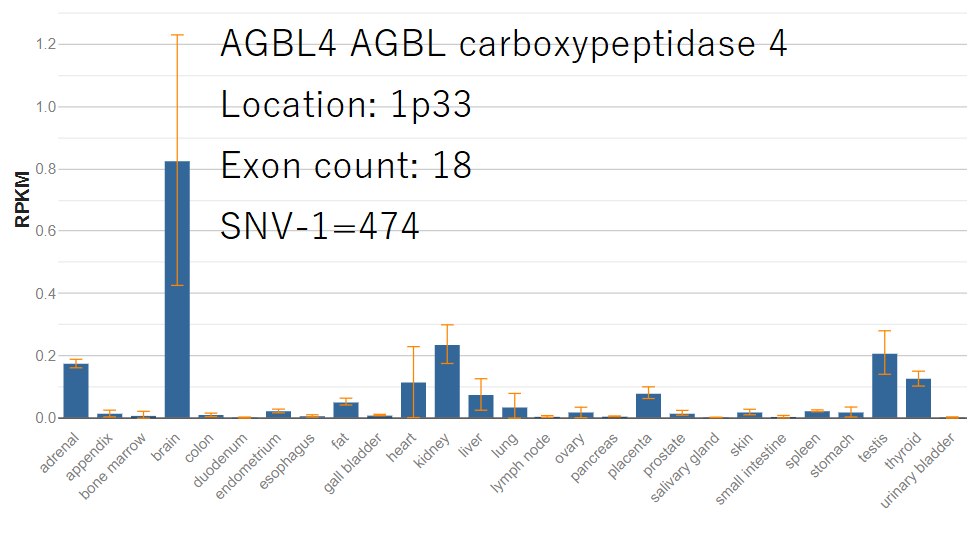 |
474 | paper[52] 認知能力 |
ASIC2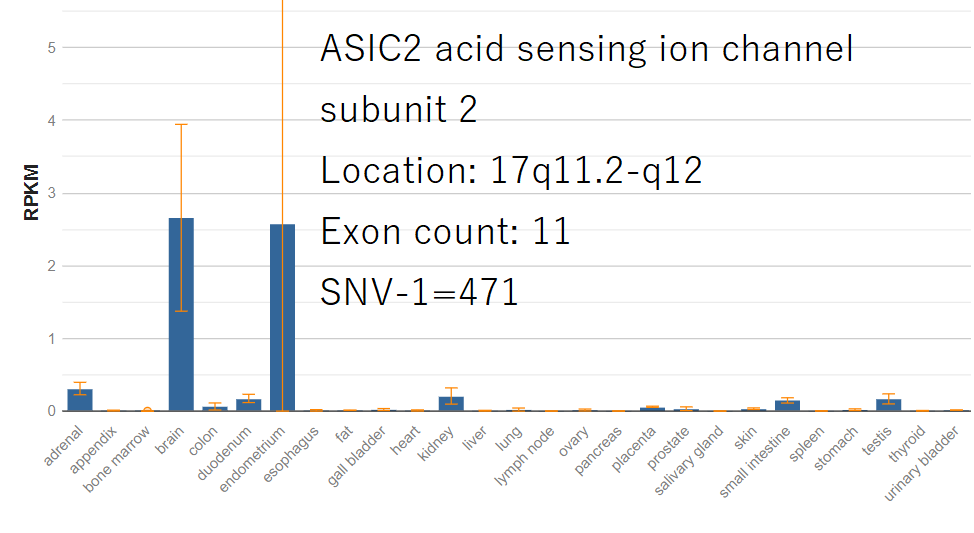 |
471 | paper[52] 統合失調症 |
CADM2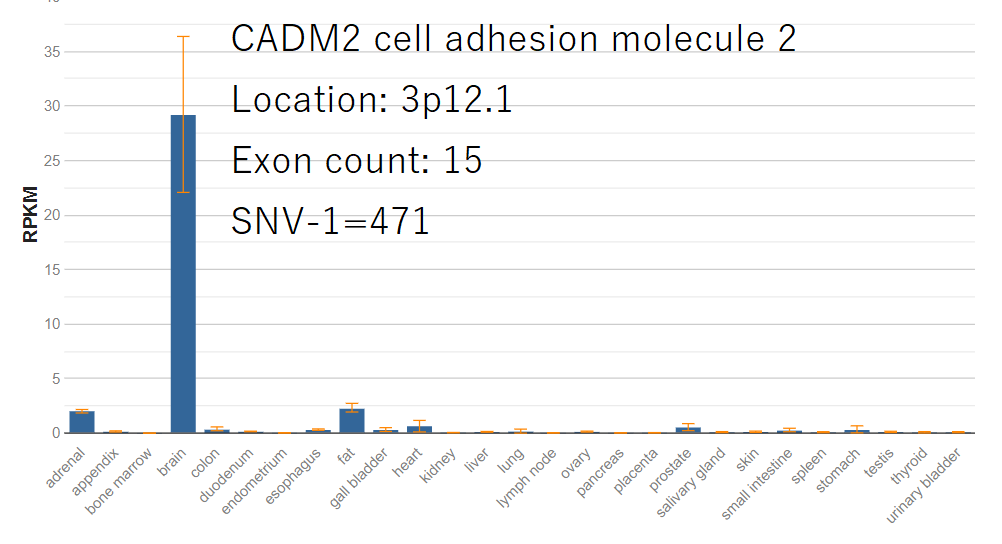 |
471 | 知能指数、rs17518584 paper[118]詳細はここにメモ paper[168] 精神疾患全般 paper[38] 認知機能 paper[88] |
CDH12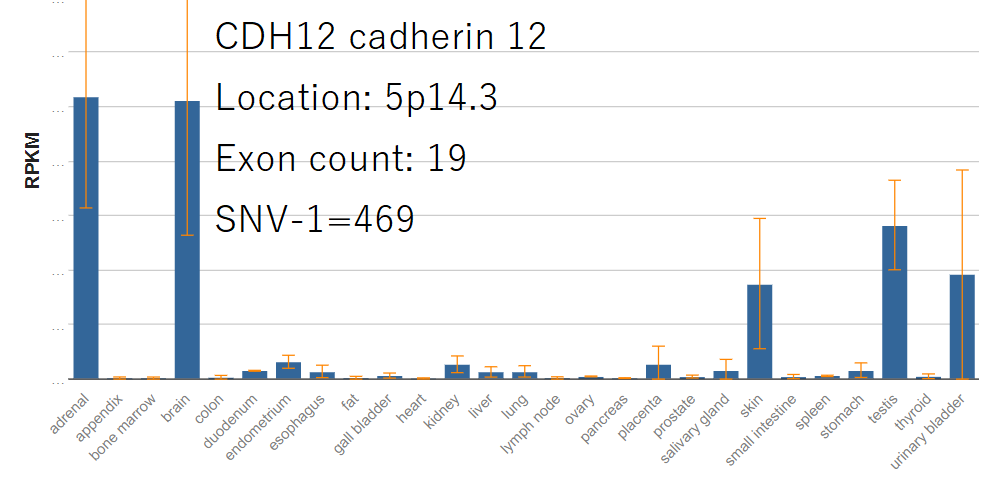 |
469 | 統合失調症・双極性障害・うつ病 paper[24] |
|
ZDHHC11 NCBIでは、脳は第5順位に過ぎない |
468 | 知能 paper[159] |
ADARB2 |
468 | 自閉症 paper[53] |
DCC |
467 | 知能 paper[135] paper[168] paper[169] 不眠症 paper[161] 認知機能全般 paper[5] 注意欠陥多動症、うつ病 paper[134] 詳細メモはこの日 paper[162] 自閉症 paper[162] うつ病 paper[136] paper[137]→サンプル数約37万SNPs数は53を特定(論文メモこの日) paper[174] 統合失調症 paper[162] 衝動的行動 paper[171] paper[172] 脳容量 paper[164] |
GALNTL6 |
459 | 知能 paper[159] |
|
ANKRD36 |
458 | 該当なし アルコール依存症 paper[54] |
CDH4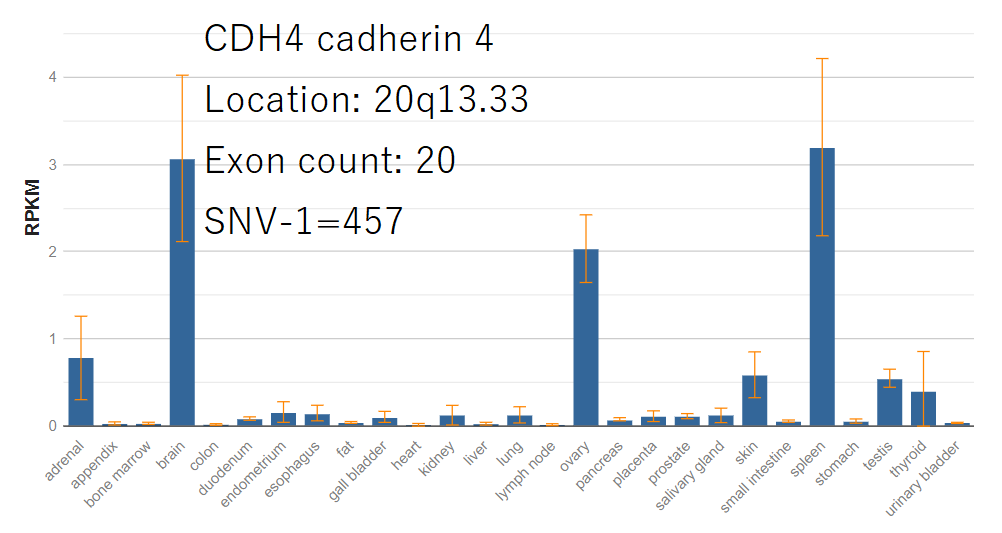 |
457 | 知能 paper[168] 統合失調症 paper[25] |
|
PRR4 NCBIでは唾液線が関連部位として明確に表示される |
457 | 統合失調症 paper[55] |
LRRC4C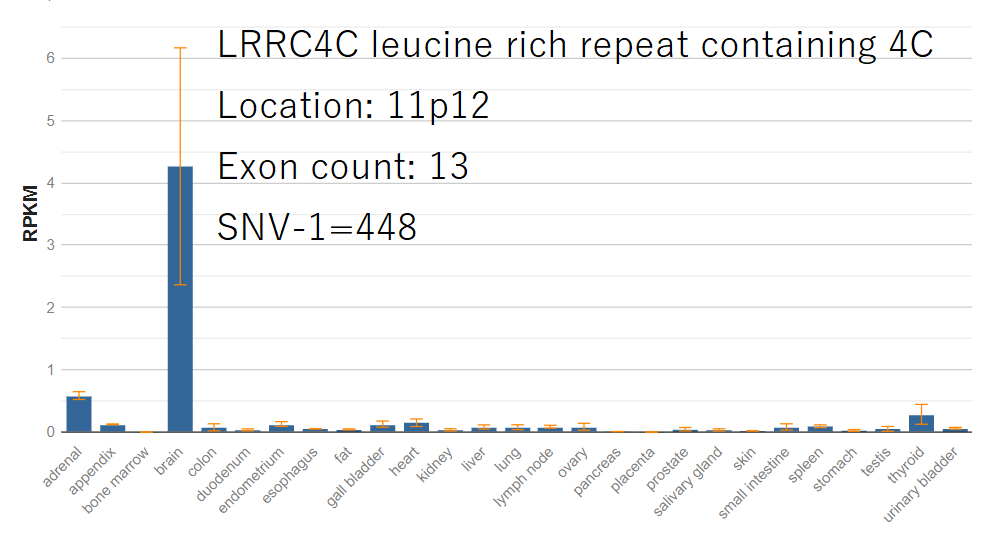 |
448 | 知能 paper[159] 拒食症 paper[5] 統合失調症synaptic adhesion paper[125] |
|
MIR44351HG |
445 | 該当なし |
|
LINC00960 |
443 | 統合失調症 paper[56] |
|
SLC9B1P4 |
442 | 該当なし |
PTPRT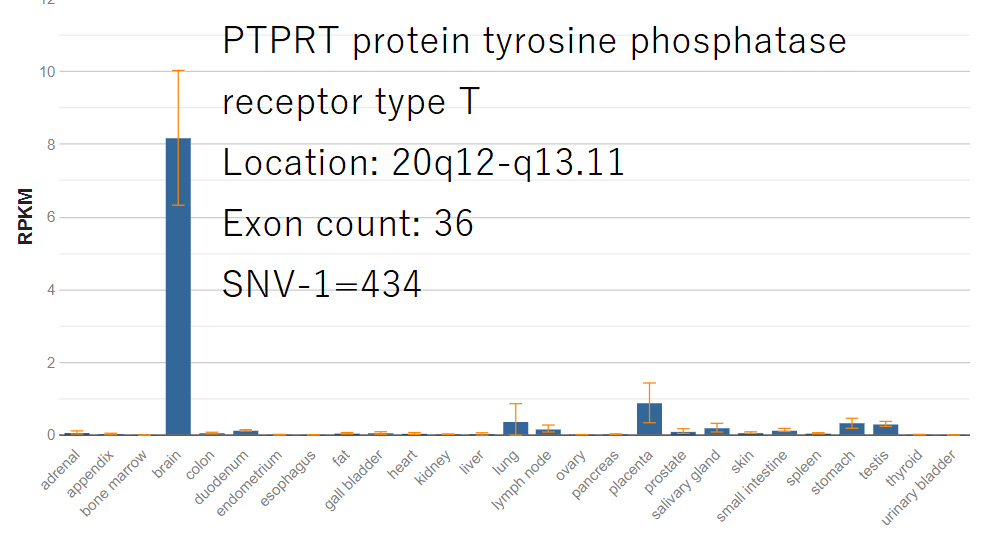 |
434 | 知能 paper[168] paper[169] 知的障害 paper[58] 自閉症 paper[165] |
|
SDK1 NCBIでは、脳との関連はごく弱い |
431 | 不眠症 paper[161] 幼児虐待 paper[59] 反社会性パーソナリティー障害 paper[176] |
|
PARD3B NCBIでは、ほぼ全部位が表示され、脳との関連は平均に近い |
430 | 知能 paper[159] パーソナリティー障害 paper[60] |
|
SLC9B1P1 |
425 | 該当なし |
|
TAS2R14 |
421 | 該当なし |
|
RUNX1 |
420 |
精神薄弱 paper[61] |
|
AUTS2 NCBIでは、関連部位は多岐にわたり、脳は第三順位に過ぎない |
420 | 知能 paper[168] paper[169] 知的障害 自閉症 paper[111] メモはこのページ 統合失調症・自閉症 paper [42],[53] |
CSMD3 |
418 | 自閉症 paper[62] 神経発達症 (DSM-5) paper[180] |
NRXN1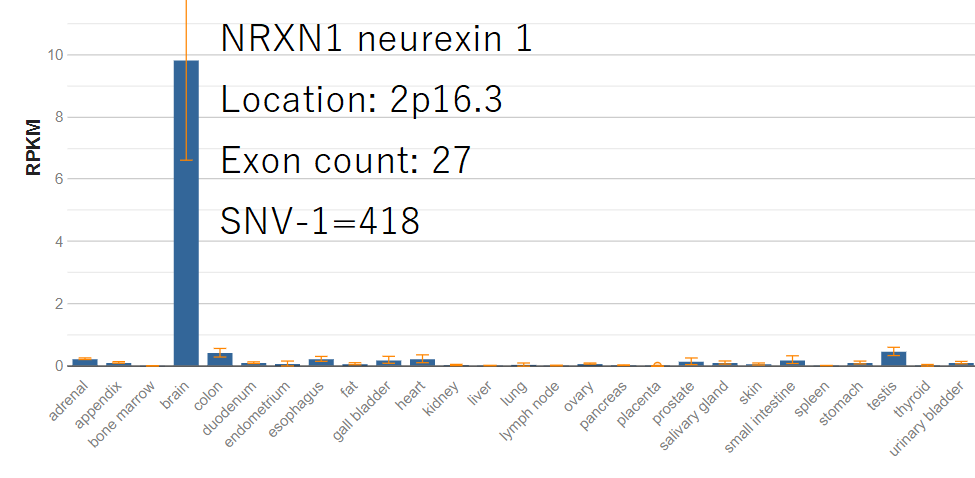 |
418 | 知能 paper[159] 知的障害 自閉症 paper[109] 自閉症・統合失調症 paper[35] paper[95] 自閉症 paper[117] 統合失調症 synaptic adhesion paper[125] 精神障害全般・言語発達障害・統合失調症・自閉症 paper[131] paper[167] |
|
LINC00955 |
418 | 該当なし |
|
ZNF385D |
418 | 統合失調症 paper[63] |
|
PRKG1 |
417 | 注意欠陥多動性障害 paper[64] 衝動的行動 paper[172] |
CAMTA1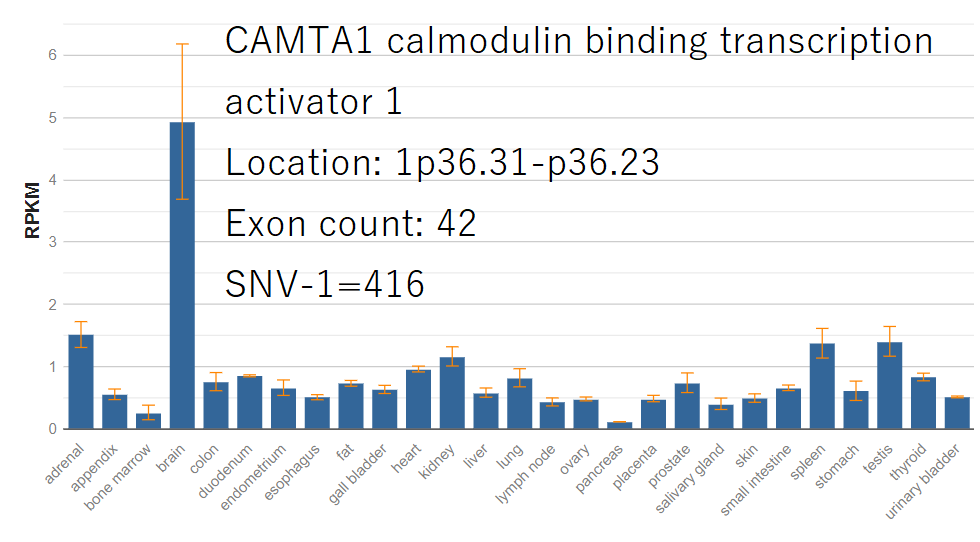 |
416 | 知能 paper[159] paper[169] 記憶能力 paper[65] |
|
SPAG16 |
414 | 双極性障害 paper[66] paper[156] |
TMEM132D |
410 | 知能 paper[159] パニック障害 paper[67] 不安症 paper[165] |
|
ROBO1 |
409 | 数学及び言語に関する能力 paper[68] |
|
GPC6 |
408 | 自閉症 paper[69] paper[137] |
|
NBPF1 |
407 | 脳容量 paper[92] |
LRRTM4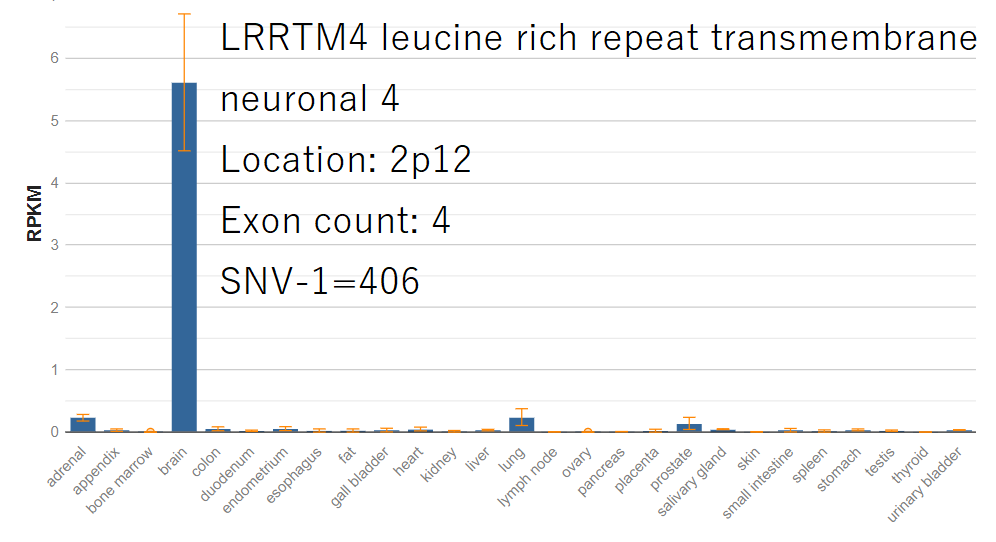 |
406 | 該当なし トゥレット症候群 paper[70] |
|
NOTCH2NL この遺伝子がヒト固有であることを発見したのは日本人である NCBIでは、NOTCHNLA,NOTCHNLB,NOTCHNLCの3区分としている。いずれも、脳との突出した関係を示さない |
405 | 脳容量 ppaper[71] ヒトの頭脳の進化 paper[105] |
|
NCOR1P2 |
402 | 該当なし(血圧) |
|
TTC34 |
400 | 該当なし |
NKAIN2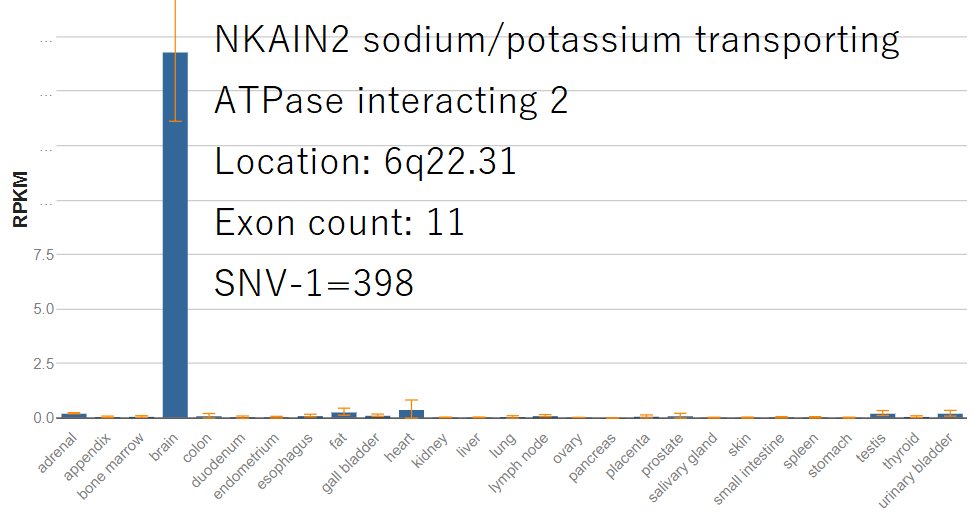 |
398 | 知能 paper[72] 統合失調症 paper[72] |
|
SMYD3 |
397 | 精神薄弱
paper[41] |
|
RPTOR 画像は省略するが、NCBIでは関連部位として脳が第一順位である。ただし、関連部位は多岐にわたり、脳が突出して表示されてはいない |
395 | 知能 paper[159] 統合失調症 paper[40] |
|
AC090044.1 |
394 | 該当なし |
OPCML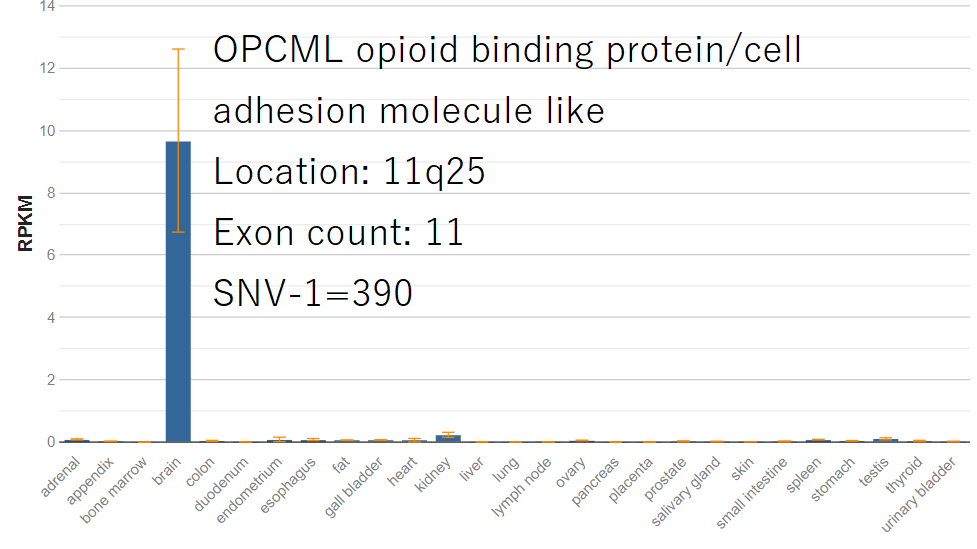 |
390 | 統合失調症 paper[37] paper[165] |
|
SNX29 NCBIでは、腎臓が関連部位として明確に表示される |
390 | 知能 paper[168] paper[169] 不眠症 paper[161] 教育達成度 paper[5] 自閉症 paper[26] |
|
NRG1 NCBIでは、関連部位として脳はごく弱くしか表示されない |
388 | 注意欠陥多動性障害 paper[2] 双極性障害 paper[104] 統合失調症 paper[11]paper[87] 統合失調症synaptic plasticityrelated genes paper[125] |
ERBB4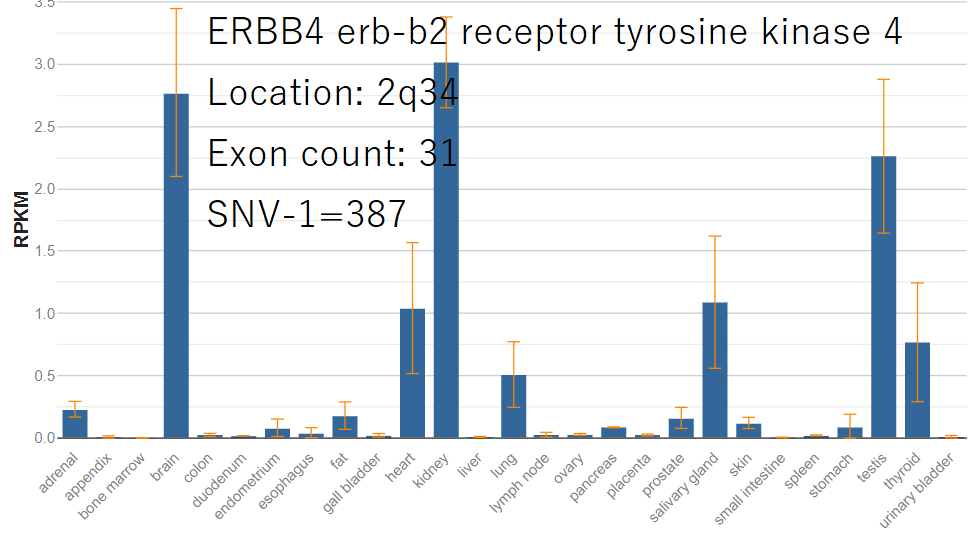 |
387 | 知能 paper[159] 統合失調症 paper[36] 自閉症 paper[117] |
ERC2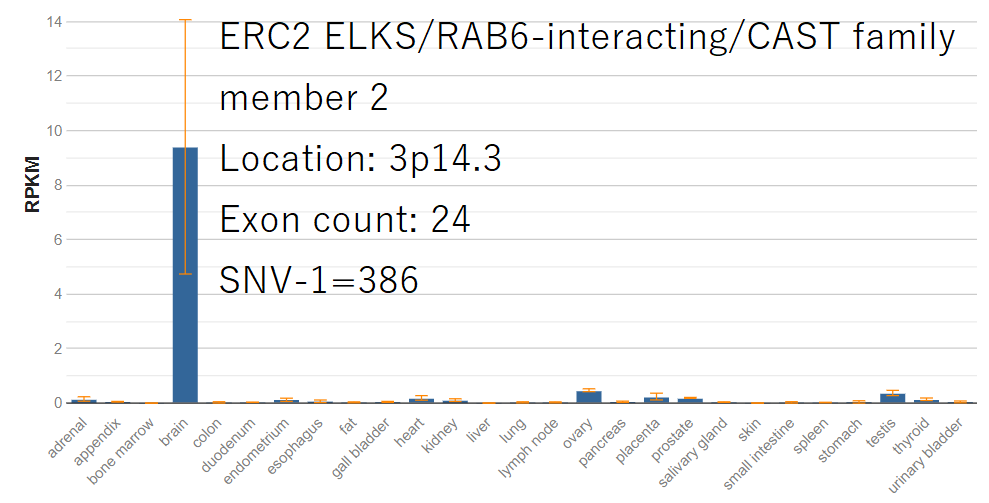 |
386 | 自閉症,統合失調症 paper[35] 統合失調症・注意欠陥多動性障害 paper[126] |
NTM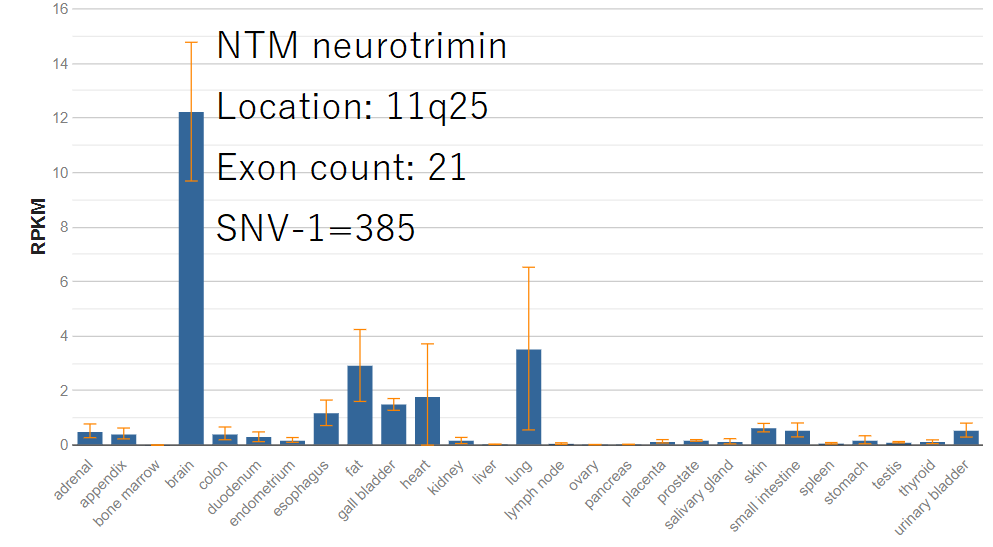 |
385 | 不眠症 paper[161] 知能指数 paper[34] |
|
SRGAP2B |
383 | 頭脳の発達 paper[83] |
|
SLC9B1P3 |
383 | 該当なし |
|
CNTNAP3B |
379 | 認知障害 paper[39] Appendix 4 |
GRM7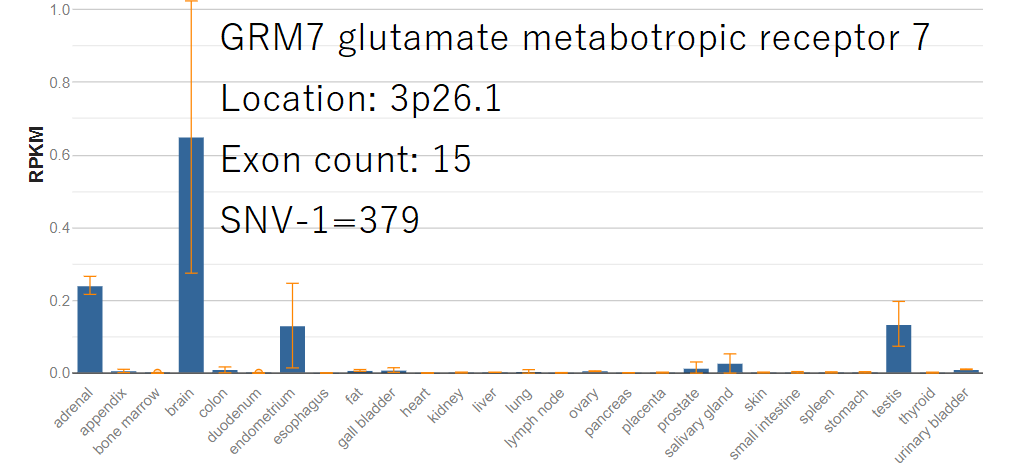 |
379 | 双極性障害 paper[33] |
CACNA2D3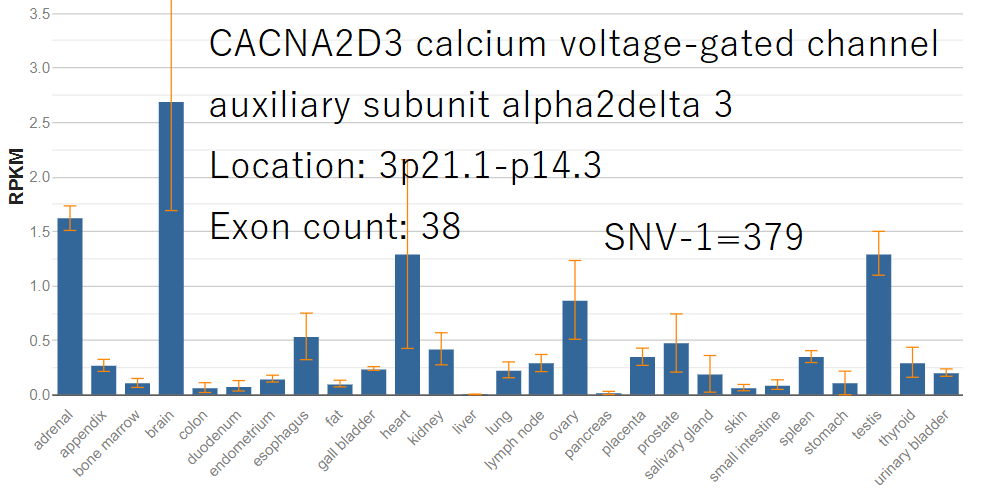 |
379 | 統合失調症 paper[32] 統合失調症 paper[125] 反社会性パーソナリティー障害 paper[176] |
|
MIR663A |
376 | 該当なし |
SNTG1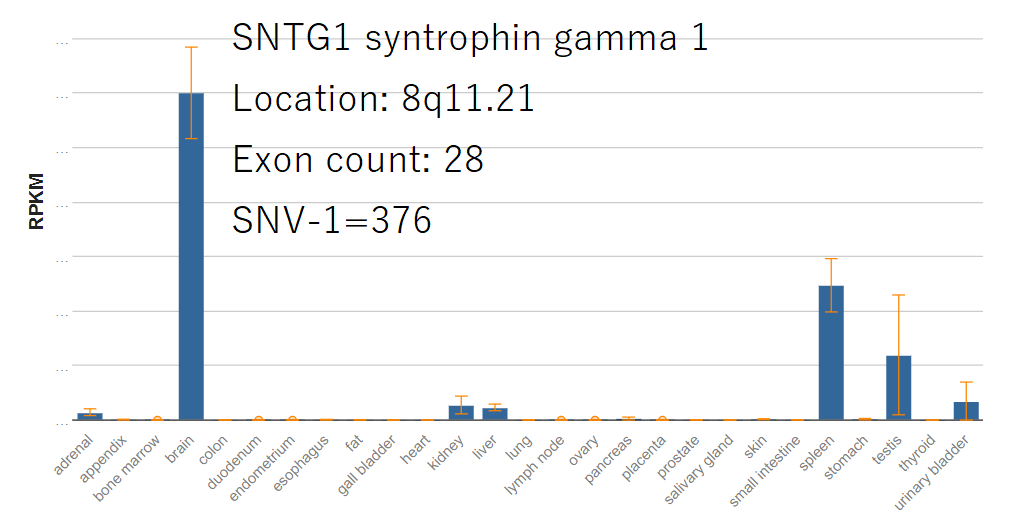 |
376 | 大脳皮質 paper[163] |
|
SUMF1 |
374 | 精神薄弱 paper[31] |
SORCS2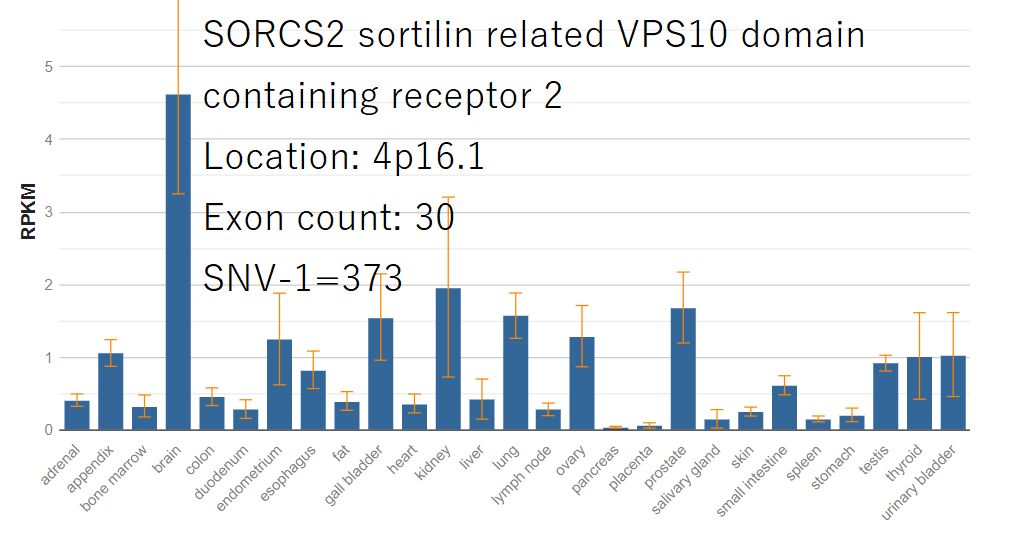 |
373 | 双極性障害, paper[30] paper[165] |
|
DMD |
373 | 自閉症 paper[117] |
|
HYDIN |
372 | 脳容量 paper[85] |
DGKB |
372 | 認知機能 paper[29] |
NRG3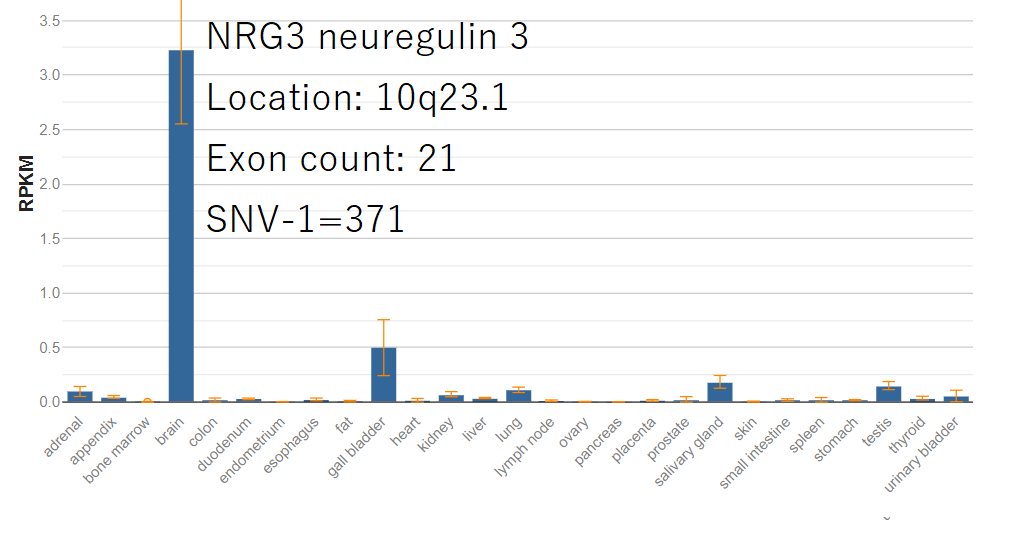 |
371 | 統合失調症 paper[28] 統合失調症 synaptic plasticityrelated genes paper[125] |
|
FAM182B |
369 | 該当なし |
|
TEKT4P2 |
368 | 該当なし |
|
DIP2C 画像は省略する。脳が第2順位であるが他の部位と比べて、突出していない |
367 | 精神疾患全般 paper[27] |
|
AGBL1 |
366 | 自閉症 paper[26] |
CDH18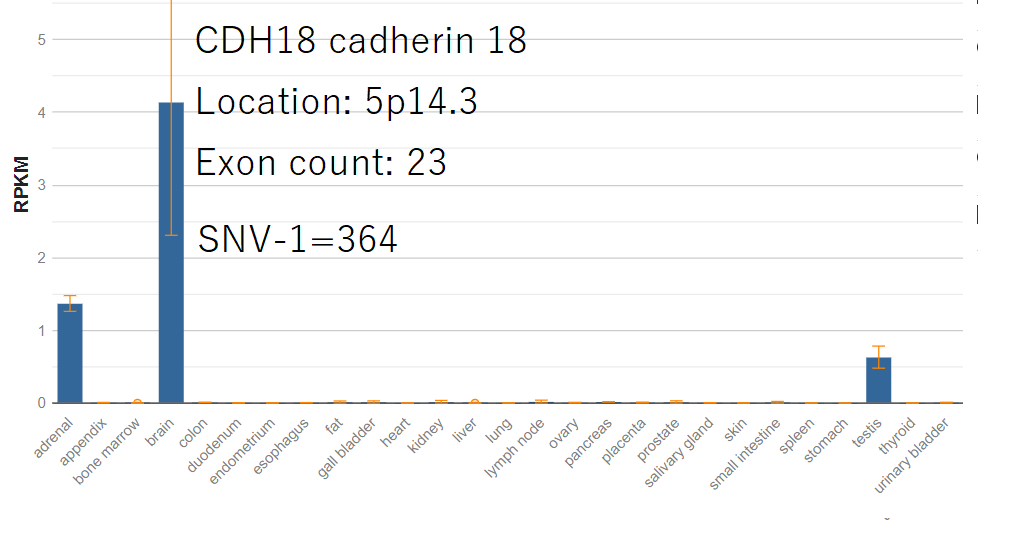 |
364 | 統合失調症,双極性障害,うつ病 paper[24] |
|
HERC2P3 |
364 | 注意欠陥多動性障害 paper[23] |
|
FRG2C |
363 | 注意欠陥多動性障害 paper[23] |
|
TRPM3 |
359 | 知的障害 paper[22] |
|
TRAPPC9 |
358 | 精神薄弱
paper[21] 知的障害 paper[133] 詳細はこの日にメモ |
ERICH1AS1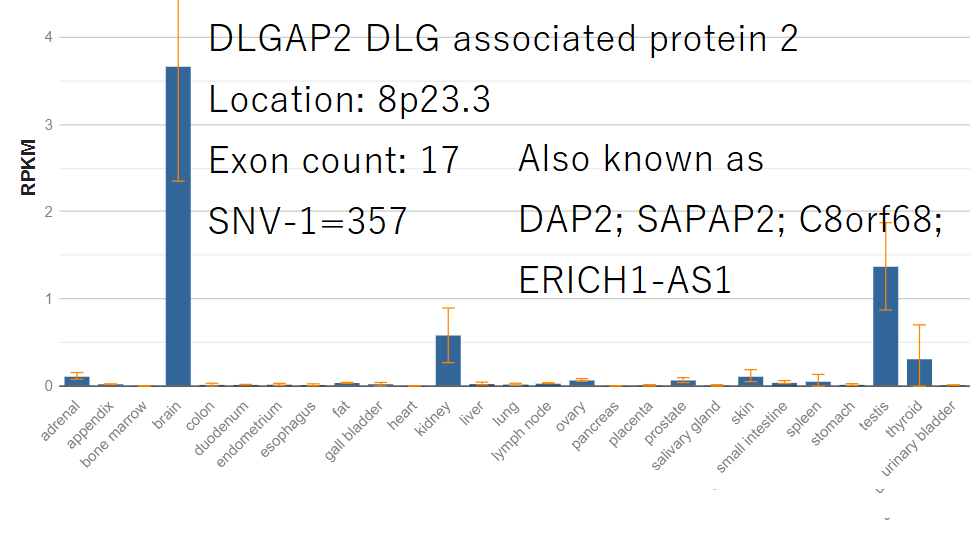 |
357 | 統合失調症 paper[5] |
DLGAP1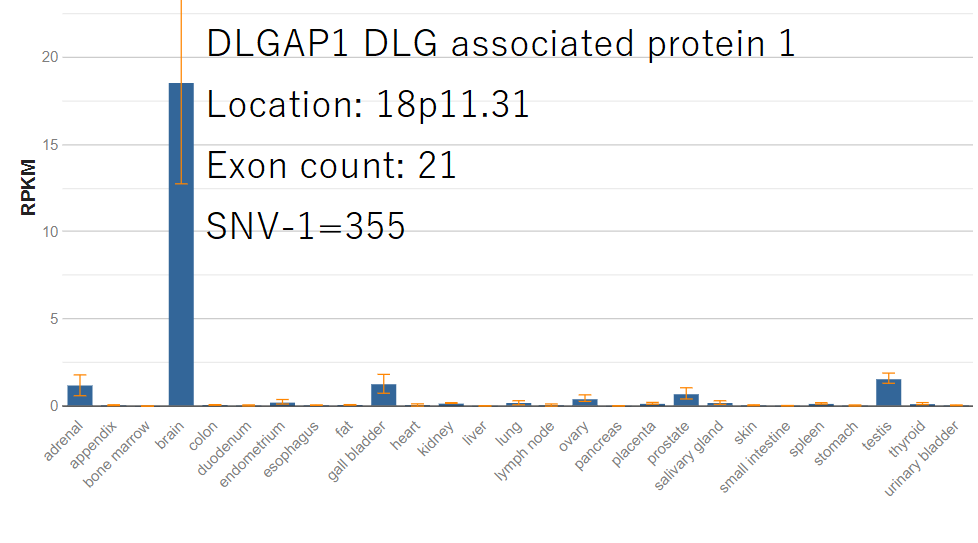 |
355 | 統合失調症 paper[20] |
|
HDAC9 |
354 | 統合失調症 paper[19] |
CTNND2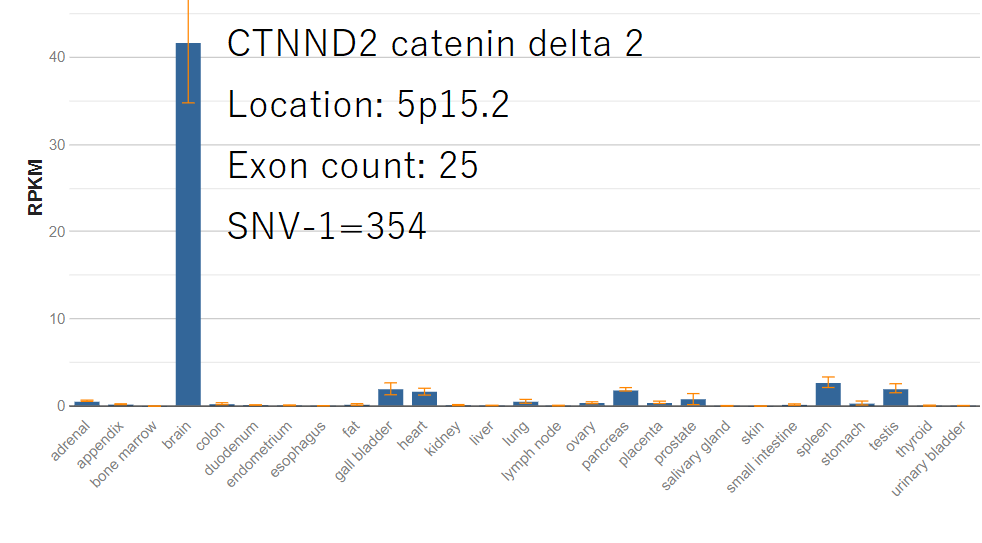 |
354 | 知能 paper[159] 知的障害 paper[18] |
| C10orf11 | 351 | 大脳皮質 paper[163] |
ASTN2 |
348 | 脳容量 paper[164] 統合失調症、双極性障害、自閉症 paper[165] |
CNTNAP5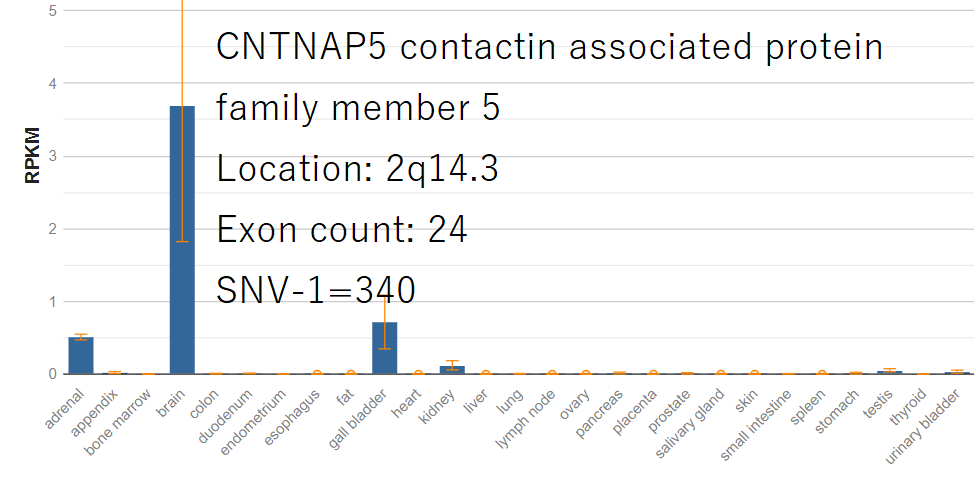 |
340 | 双極性障害 paper[160] |
PCDH9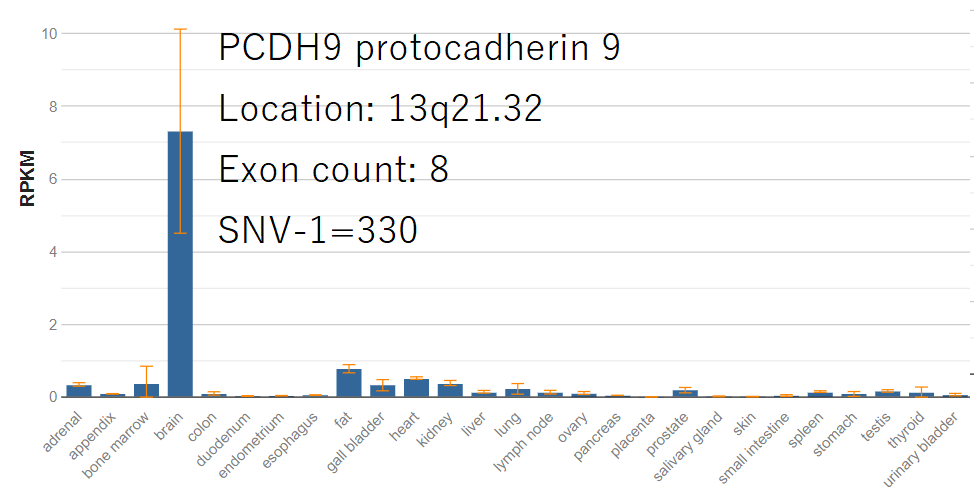 |
330 | 知的障害、 自閉症 paper[109] |
|
SHANK2 この遺伝子には精神疾患関連論文が極めて多数あり。しかし、不思議なことに統合失調症との関連を示す論文はない。 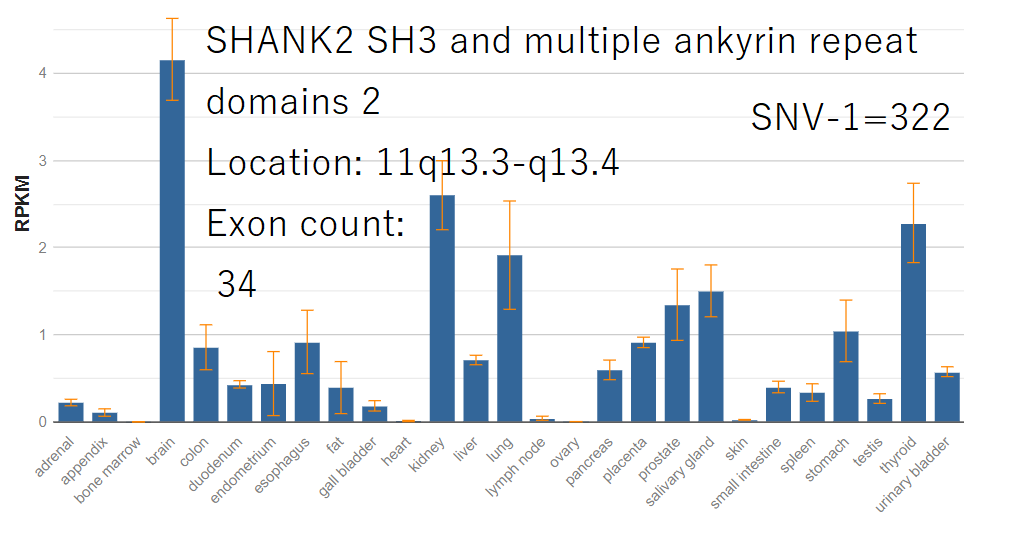 |
322 | 知的障害、自閉症 paper[109] paper[109] 詳細このページメモ paper[151] paper[152] paper[153] paper[154] うつ病 paper[129] paper[157] 自閉症、注意欠陥多動性障害 paper[149] 神経精神障害 paper[150] 注意欠陥多動症 paper[155] |
| FIP1L1 | 320 | 大脳皮質 paper[163] |
|
EXOC4 知能との関連を示す論文が多いにもかかわらず、NCBIでは関連部位は多岐にわたり、脳は第2位で表示さるに過ぎない |
320 | 知能 paper[147] paper[135] paper[168] paper[169] |
|
DPYD NCBIでは、脳は関連部位としてごく小さくしか表示されない |
319 | ボーダーラインパーソナリティー障害 paper[97] 自閉症 paper[117] 知能 paper[159] paper[168] |
| LARGE | 317 | 知能 paper[159] paper[168] |
NEGR1 |
312 | 不眠症 paper[161] 知能 paper[135] paper[147] paper[168] paper[169] うつ病 paper[158] |
CALN1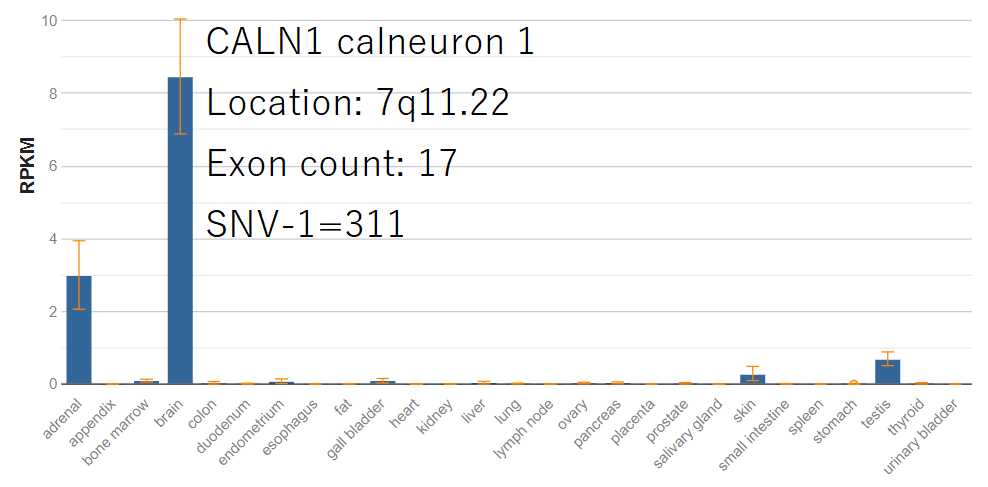 |
311 | 知能 paper[159] paper[168] paper[169] |
NPAS3 |
309 | 不眠症 paper[161] 知能 paper[159] 統合失調症 paper[165] |
| THSD7B | 306 | 知能 paper[159] 反社会性パーソナリティー障害 paper[176] |
AGAP1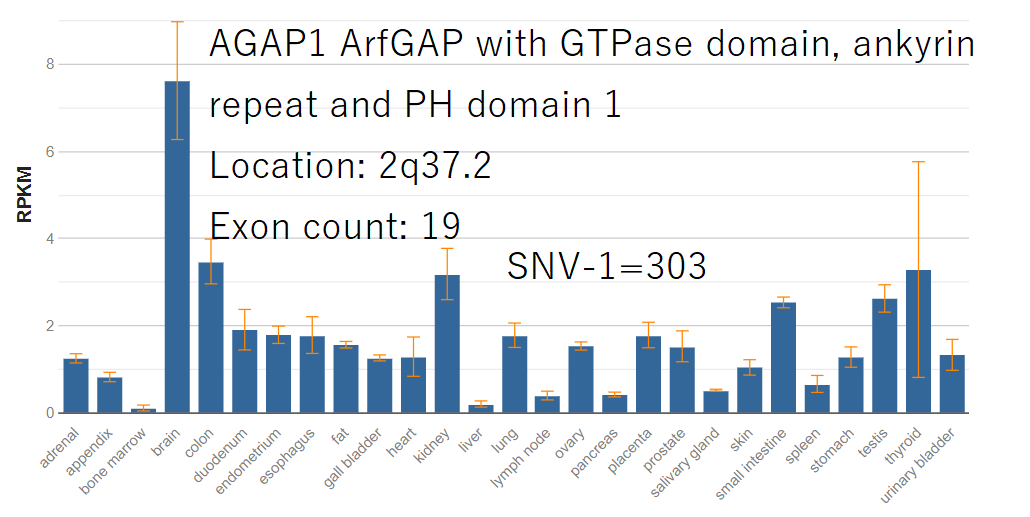 |
303 | 知能 paper[159] paper[168] paper[169] |
|
CACNA1C 統合失調症との関連を示す論文が多いにもかかわらず、NCBIの関連部位では、脳は第三順位に過ぎない。子宮内膜→心臓→脳 |
302 | 自閉症 paper[177] 統合失調症 paper[95] paper[141] paper[148] paper[166] paper[166] paper[181] |
| THOC3 | 285 | 知能 paper[159] SNV35=35 |
|
DDAH1 |
285 | 双極性障害 paper[160] SNV35=75 重要 |
|
ZNF806 |
270 | SNV35=117。該当なし、アルツハイマー病のみ paper[146] |
|
KIRREL3 |
245 | 知的障害、自閉症 paper[109] |
|
FOXP1 |
244 | 知的障害(SNV35=1) paper[108] |
|
AFF3 |
265 | 非症候性知的障害 paper[106] 知的障害 paper[107] |
|
ARHGAP15 |
231 | 知能 paper[135] |
|
CACNA1B |
220 | 統合失調症 SNV35=26 paper[96] |
|
SCAPER |
176 | 知的障害 paper[133] 詳細はこの日にメモ |
|
TRIO |
169 | 知的障害 paper[108] |
|
OR4C3 SNV35=48 |
163 | 注意欠陥多動症、うつ病 paper[134] 詳細メモはこの日 NCBIでは嗅覚受容体 |
|
OR4C5 SNV35=49 |
155 | 統合失調症 ppaper[90] 注意欠陥多動症、うつ病 paper[134] 詳細メモはこの日 NCBIでは嗅覚受容体 |
|
ARID1B |
146 | 知的障害 paper[108] |
|
MED13L |
119 | 知的障害 paper[108] 詳細このページメモ |
|
DYSF |
110 | 知能 SNV35=1 paper[135] |
結論
①世界中の集団遺伝学研究者は、韓国人集団遺伝学者がほとんど引用しないため、読まれることが少く引用数も少ないが、事実上はアメリカ政府食品医薬品局(FDA)毒物研究センターが執筆した論文を読むべきである。
②日本人の病理遺伝学研究者は、FDA論文にて抽出された朝鮮人固有の遺伝子変異リストに基づき、研究を進めるべきである。現状では、このリストは、日本で全く知られていない。 また、精神科医は、在日韓国・朝鮮人及び帰化済み朝鮮人への投薬時には、特段の配慮が必要である
③日本の文化人類学者は、韓国社会の異様性・病身性を徹底的に分析するべきである。その際には、DNAが朝鮮人である者の協力を絶対に求めるべきではない。
④日本人の起源を探求している研究者は、DNAが朝鮮人である者を研究グループから絶対に排除するべきである。
記事筆者は、アメリカ政府食品医薬品局(FDA)毒物研究センターが執筆した論文及び同論文にて抽出された韓国人固有の遺伝子変異リストと上記の結果からみて、韓国人は精神面から見た場合には、完全なDNA異常集団であると絶対の自信をもって言い切る。
そして、韓国人の精神面でのDNAの異常性こそ、全63もの国際的な科学関連賞の受賞者がただの一人もいないという客観的事実に完全に合致し、かつ、韓国の合計特殊出生率の異常を極めた低下(2022年で0.78)が端的に示すように病身国家韓国を生み出した主原因である

*論文名一覧
paper[1]
Rare coding variants in 10 genes confer substantial risk for schizophrenia.
Singh TJ et al.
Nature. April 6, 2022
paper[2]
an intriguing therapeutic target for neurodevelopmental disorders
Liang Shi & Clare M. Bergson
Nature Published: 16 June 2020
paper[3]
An interaction network of mental disorder proteins in neural stem cells
M J Moen et al,
Nature Published: 04 April 2017
paper[4]
Association between SNPs and gene expression in multiple regions of the human brain
S Kim et al,
Nature Published: 08 May 2012
paper[5]
Identification of pleiotropy at the gene level between psychiatric disorders and related traits
Tatiana Polushina et al,
Nature Published: 29 July 2021
[cited from the above paper]
Here, we aimed to identify genetic overlaps at the gene level between 7 mental disorders (schizophrenia, autism spectrum disorder, major depressive disorder, anorexia nervosa, ADHD, bipolar disorder and anxiety), 8 brain morphometric traits, 2 cognitive traits (educational attainment and general cognitive function) and 9 personality traits (subjective wellbeing, depressive symptoms, neuroticism, extraversion, openness to experience, agreeableness and conscientiousness, children’s aggressive behaviour, loneliness) based on publicly available GWASs.
paper[6]
A Genomewide Linkage Scan of Cocaine Dependence and Major Depressive Episode in Two Populations
BaoZhu Yang et ai.
Nature Published: 17 August 2011
paper[7]
Exome sequencing for bipolar disorder points to roles of de novo lossoffunction and proteinaltering mutations
M Kataoka et al.
Nature Published: 24 May 2016
paper[8]
Genomewide association study in obsessivecompulsive disorder: results from the OCGAS
M Mattheisen
Nature Published: 13 May 2014
paper[9]
The SchizophreniaAssociated Gene, CSMD1,Encodes a BrainSpecific Complement Inhibitor
Matthew L Baum
Harvard Libraly
paper[10]
CNTNAP2 gene dosage variation is associated with schizophrenia and epilepsy
J I Friedman et al.
Nature Published: 24 July 2007
paper[11]
The molecular genetics of schizophrenia: new findings promise new insights M J Owen et al.
Nature Published: 28 October 2003
paper[12]
A genomewide investigation into parentoforigin effects in autism spectrum disorder identifies previously associated genes including SHANK3
Siobhan Connolly et al.
Nature Published: 23 November 2016
paper[13]
Convergence of evidence from a methylomewide CpGSNP association study and GWAS of major depressive disorder
Karolina A. Aberg et al.
Nature Published: 22 August 2018
[cited from the above paper]
ROBO2 (roundabout, axon guidance receptor, homolog 2) is critical for the maintenance of inhibitory synapses in the adult ventral tegmental area, a brain region important for the production of dopamine[41], and has been implicated in schizophrenia[42],[43],[44] and bipolar depression[45].
paper[14]
Identification of 11 potentially relevant gene mutations involved in growth retardation, intellectual disability, joint contracture, and hepatopathy
Hongyan Diao et al.
Published online 2018 Nov 16
paper[15]
Association of limbic systemassociated membrane protein (LSAMP) to male completed suicide
Anne Must et al.
Published: 23 April 2008
[cited from above paper]
According to the results of the current study, there might be a chance that variations in LSAMP gene play a role in pathoaetiology of suicidal behaviour.
paper[16]
The role of cadherin genes in five major psychiatric disorders: A literature update
Ziarih Hawi et al.
published: 18 September 2017
paper[17] Chromosome aberrations involving 10q22: report of three overlapping interstitial deletions and a balanced translocation disrupting C10orf11
Andreas Tzschach et al.
Nature Published: 21 October 2009
paper[18]
CTNND2— a candidate gene for reading problems and mild intellectual disability
Wolfgang Hofmeister et al.
February 3, 2015
paper[19]
HDAC9 is implicated in schizophrenia and expressed specifically in postmitotic neurons but not in adult neural stem cells
Bing Lang et al.
Published online 2011 Aug 18.
paper[20]
Genetic analysis of the DLGAP1 gene as a candidate gene for schizophrenia
JunMing Liet al
30 January 2013
paper[21]
Identification of Mutations in TRAPPC9, which Encodes the NIK and IKKβBinding Protein, in Nonsyndromic AutosomalRecessive Mental Retardation
Asif Mir et al.
11 December 2009
paper[22]
Diseaseassociated mutations in the human TRPM3 render the channel overactive via two distinct mechanisms
Siyuan Zhao et al.
eLife 2020
paper[23]
De novo and inherited CNVs in MZ twin pairs selected for discordance and concordance on Attention Problems
Erik A Ehli et al.
Nature Published: 11 April 2012
paper[24]
A novel relationship for schizophrenia, bipolar and major depressive disorder Part 5: a hint from chromosome 5 high density association screen
Xing Chen et al.
Published online 2017 May 15.
paper[25]
Neuronal cell adhesion genes Key players in risk for schizophrenia, bipolar disorder and other neurodevelopmental brain disorders?
Aiden P. Corvin
01 Oct 2010
paper[26]
Genomewide association analysis of autism identified multiple loci that have been reported as strong signals for neuropsychiatric disorders
Lu Xia et al.
published: 24 October 2019
paper[27]
Integrated multiomics reveal epigenomic disturbance of assisted reproductive technologies in human offspring
WeiChen et al.
Volume 61, November 2020
paper[28]
Neuregulin 3 (NRG3) as a susceptibility gene in a schizophrenia subtype with florid delusions and relatively spared cognition
B Morar et al.
Nature
Published: 15 June 2010
paper[29]
Genetic Basis of a Cognitive Complexity Metric
Narell K. Hansell et al.
Published: April 10, 2015
[cited from the above paper] Abstract
Relational complexity (RC) is a metric reflecting capacity limitation in relational processing. It plays a crucial role in higher cognitive processes and is an endophenotype for several disorders. However, the genetic underpinnings of complex relational processing have not been investigated. Using the classical twin model, we estimated the heritability of RC and genetic overlap with intelligence (IQ), reasoning, and working memory in a twin and sibling sample aged 1529 years (N = 787). Further, in an exploratory search for genetic loci contributing to RC, we examined associated genetic markers and genes in our Discovery sample and selected loci for replication in four independent samples (ALSPAC, LBC1936, NTR, NCNG), followed by metaanalysis (N>6500) at the single marker level. Twin modelling showed RC is highly heritable (67%), has considerable genetic overlap with IQ (59%), and is a major component of genetic covariation between reasoning and working memory (72%). At the molecular level, we found preliminary support for four singlemarker loci (one in the gene DGKB), and at a genebased level for the NPS gene, having influence on cognition. These results indicate that genetic sources influencing relational processing are a key component of the genetic architecture of broader cognitive abilities. Further, they suggest a genetic cascade, whereby genetic factors influencing capacity limitation in relational processing have a flowon effect to more complex cognitive traits, including reasoning and working memory, and ultimately, IQ.
paper[30]
SorCS2 is required for BDNFdependent plasticity in the hippocampus
S Glerup el al.
Nature Published: 26 July 2016
paper[31]
Candidate genes for recessive nonsyndromic mental retardation on chromosome 3p (MRT2A)*
JJ Higgins et al
published: 18 May 2004
paper[32]
Genetic Evaluation of Schizophrenia Using the Illumina HumanExome Chip
Tim Moons et al.
March 30, 2016
paper[33]
Allelic Association, DNA Resequencing and Copy Number Variation at the Metabotropic Glutamate Receptor GRM7 Gene Locus in Bipolar Disorder
Radhika Kandaswamy et al.
Accepted: 14 April 2014
paper[34]
NTM and NR3C2 polymorphisms influencing intelligence: Familybased association studies
Yue Pan et al.
Progress in NeuroPsychopharmacology & Biological Psychiatry 35 (2011) 154–160
paper[35]
CNTNAP2 and NRXN1 Are Mutated in AutosomalRecessive PittHopkinslike Mental Retardation and Determine the Level of a Common Synaptic Protein in Drosophila
ChristianeZweier et al
13 November 2009,
paper[36]
Schizophrenia Candidate Gene ERBB4: Covert Routes of Vulnerability to Psychosis Detected at the Population Level
Nicholas C. Stefanis
March 2013
paper[37]
OPCML Gene as a Schizophrenia Susceptibility Locus in Thai Population
Benjaporn Panichareon
Published: 21 July 2011
paper[38]
Genetic variation in CADM2 as a link between psychological traits and obesity
Julia Morris et al
Nature Published: 14 May 2019
paper[39]
Ancient Migrations The first complete genome assembly, annotation and variants of the 2 ZoroastrianParsi community of India
Naseer Pasha et al
February 17, 2021
paper[40]
Altered DNA methylation associated with a translocation linked to major mental illness
Daniel L. McCartney et al.
Nature Published: 19 March 2018
[cited from the above paper] Twentytwo of the DMRs identified were within the major histocompatibility complex (MHC; Fig. 3), which has been implicated in the pathogenesis of SZ through a largescale GWAS.16 In addition, we identified DMRs within two additional genes (IGSF9B, CNTN4) that showed genomewide association with SZ in the same study.
Two additional DMRs were identified within genes associated with SZ at the genomewide significant level by the SZ Working Group of the Psychiatric Genomics Consortium (PGC).16 These were within the genes IGSF9B and CNTN4, both of which function as cell adhesion molecules. Two largescale epigenomewide association studies of SZ have recently been reported.12,13 These studies reported significant differential methylation in RPTOR: a gene in which we identified a DMR. RPTOR is a key component of mTOR signalling, which has been implicated in synaptic plasticity.36
paper[41]
Derivative chromosome 1 and GLUT1 deficiency syndrome in a sibling pair
Dilek Aktas et al.
Published: 28 May 2010
paper[42]
Rare structural variants found in attentiondeficit hyperactivity disorder are preferentially associated with neurodevelopmental genes
J Elia et al
Nature Published: 23 June 2009
paper[43]
GWAS MetaAnalysis Reveals Shared Genes and Biological Pathways between Major Depressive Disorder and Insomnia
YiSian Lin
Published: 26 September 2021
paper[44]
The Gene Encoding Disabled1 (DAB1), the Intracellular Adaptor of the Reelin Pathway, Reveals Unusual Complexity in Human and Mouse*
Isabelle Bar et al.
FEBRUARY 2003
paper[45]
Postaxial polydactyly type A2, overgrowth and autistic traits associated with a chromosome 13q31.3 microduplication encompassing miR1792 and GPC5
P.Kannu et al.
8, August 2013
paper[46]
GenomeWide Association Study for Autism Spectrum Disorder in Taiwanese Han Population
PoHsiu Kuo et al.
2015 Sep 23
paper[47]
Genetic Dissection of Temperament Personality Traits in Italian Isolates Maria Pina Concas et al. 21 December 2021
paper[48]
Attention, cognitive control and motivation in ADHD: Linking eventrelated brain potentials and DNA methylation patterns in boys at early school age
Hartmut Heinrich et al
. Published: 19 June 2017
paper[49]
Association study of the PDE4D gene and obsessivecompulsive disorder in a Chinese Han population
Huang, Xing et al.
December 2019
paper[50]
KCNIP4 as a candidate gene for personality disorders and adult ADHD
LenaWeißflog et al. 2012.07.017
paper[51]
Implication of synapserelated genes in bipolar disorder by linkage and gene expression analyses
Catalina Lopez de Lara
2010 Jul 29
paper[52]
EpigenomeWide Association Study of Cognitive Functioning in MiddleAged Monozygotic Twins
Anna Starnawskal et al
12 December 2017
paper[52]
Host genetics influences the relationship between the gut microbiome and psychiatric disorders
ThaisMartinsSilva
2 March 2021
paper[53]
Identification of a functional rare variant in autism using genomewide screen for monoallelic expression
Eyal BenDavid et al
15 September 2011
paper[54]
Genomewide association study for maximum number of alcohol drinks in European Americans and African Americans
Ke Xu et al
2015 Jun 3
paper[55]
Sex differences in schizophrenia: a longitudinal methylome analysis
Christopher Adanty et al
Published: 30 December 2021
paper[56]
Long noncoding RNAassociated competing endogenous RNA axes in the olfactory epithelium in schizophrenia: a bioinformatics analysis
Hani Sabaie et al.
Nature Published: 30 December 2021
paper[57]
GenomeWide Search for SNP Interactions in GWAS Data: Algorithm, Feasibility, Replication Using Schizophrenia Datasets
KwanYeung Lee et al.
Nature 28 August 2020
paper[58]
Modeling del(17)(p11.2p11.2) and dup(17)(p11.2p11.2) Contiguous Gene Syndromes by Chromosome Engineering in Mice: Phenotypic Consequences of Gene Dosage Imbalance
Katherina Walz 2003 May
paper[58]
Identification of pathogenic gene variants in small families with intellectually disabled siblings by exome sequencing
Janneke H M SchuursHoeijmakers et al
February 13, 2014
paper[59]
Exposure to childhood abuse is associated with human sperm DNA methylation
Andrea L. Roberts et al.
Nature Published: 02 October 2018
paper[60]
LENS: webbased lens for enrichment and network studies of human proteins
Adam Handen et al
Published: 09 December 2015
paper[61]
Syndromic Mental Retardation With Thrombocytopenia Due to 21q22.11q22.12 Deletion:Report of Three Patients
Eleni Katzaki et al
Accepted 3 March 2010
paper[62]
Two patients with balanced translocations and autistic disorder: CSMD3 as a candidate gene for autism found in their common 8q23 breakpoint area
Chiara Floris et al
Nature Published: 13 February 2008
paper[63]
BCL9 and C9orf5 Are Associated with Negative Symptoms in Schizophrenia: MetaAnalysis of Two GenomeWide Association Studies
Chun Xu etal.
Published: January 29, 2013
paper[64]
CaseControl GenomeWide Association of AttentionDeficit / Hyperactivity Disorder
Benjamin M. Neale et al
Published online 2010 Aug 5
paper[65]
Calmodulinbinding transcription activator 1 ( CAMTA1 ) alleles predispose human episodic memory performance
Matthew J. Huentelman et al.
Published: 30 April 2007
paper[66]
Genomewide association study of bipolar disorder in Canadian and UK populations corroborates disease loci including SYNE1 and CSMD1
Wei Xu et al.
Published: 04 January 2014
paper[67]
Replication and metaanalysis of TMEM132D gene variants in panic disorder A Erhardt et al Nature Published: 04 September 2012
paper[68]
KIAA0319 and ROBO1: evidence on association with reading and pleiotropic effects on language and mathematics abilities in developmental dyslexia
Sara Mascheretti et al
Nature Published: 16 January 2014
paper[69]
Postaxial polydactyly type A2, overgrowth and autistic traits associated with a chromosome 13q31.3 microduplication encompassing miR1792 and GPC5 P.Kannu et al Issue 8, August 2013
paper[70]
LRRTM4 Terminal Exon Duplicated in Family with Tourette Syndrome, Autism and ADHD
Raymond A. Clarke et al.
Published: 27 December 2021
paper[71]
HumanSpecific Genes, Cortical Progenitor Cells,and Microcephaly
Michael Heide
Published: 15 May 2021
paper[72]
Metaanalysis of Positive and Negative Symptoms Reveals Schizophrenia Modifier Genes
Alexis C. Edwards
Published: 27 August 2015
paper[73]
Genetic underpinnings of affective temperaments: a pilot GWAS investigation identifies a new genomewide significant SNP for anxious temperament in ADGRB3 gene Xenia Gonda et al. Nature Published: 01 June 2021
[cited from above paper] Suggestively significant findings in SNPbased tests for depressive temperament
In case of depressive temperament, genomewide SNPbased tests yielded a genomic inflation factor of λ = 1.00172. For the QQ plot, see Supplementary Fig. S3. No SNP survived Bonferroni correction for multiple testing, but five SNPs showed a suggestive significance, one of which resides in the SGCZ gene, whereas the rest are intergenic (Fig. 2 IC and Table 1).
paper[74]
Identification of novel genomewide associations for suicidality in UK Biobank, genetic correlation with psychiatric disorders and polygenic association with completed suicide
Rona J.Strawbridge
March 2019
paper[75]
Genetic Dissection of Temperament Personality Traits in Italian Isolates
Maria Pina Concas et al.
Published: 21 December 2021
paper[76]
Hippocampal overexpression of NOS1AP promotes endophenotypes related to mental disorders
FlorianFreudenberg et al.
September 2021
paper[77]
Ancestryspecific and sexspecific risk alleles identified in a genomewide geneby alcohol dependence interaction study of risky sexual behaviors
Renato Polimanti et al.
Published online 2017 Oct 9
paper[78]
Genetic mapping of habitual substance use, obesityrelated traits, responses to mental and physical stress, and heart rate and blood pressure measurements reveals shared genes that are overrepresented in the neural synapse
Majid Nikpay
Nature Published: 02 February 2012
[cited]
Links between substance use habits, obesity, stress and the related cardiovascular outcomes can be, in part, because of loci with pleiotropic effects. To investigate this hypothesis, we performed genomewide mapping in 119 multigenerational families from a population in the SaguenayLacStJean region with a known founder effect using 58 000 singlenucleotide polymorphisms and 437 microsatellite markers to identify genetic components of the following factors: habitual alcohol, tobacco and coffee use; response to mental and physical stress; obesityrelated traits; and heart rate (HR) and blood pressure (BP) measures. Habitual alcohol and/or tobacco users had attenuated HR responses to mental stress compared with nonusers, whereas hypertensive individuals had stronger HR and systolic BP responses to mental stress and a higher obesity index than normotensives. Genetic mappings uncovered numerous shared genes among substance use, stress response, obesity and hemodynamic traits, including CAMK4, CNTN4, DLG2, FHIT, GRID2, ITPR2, NOVA1 and PRKCE, forming network of interacting proteins, sharing synaptic function and display higher and patterned expression profiles in brainrelated tissues; moreover, pathway analysis of shared genes pointed to longterm potentiation.
paper[79]
An integrated analysis of rare CNV and exome variation in Autism Spectrum Disorder using the Infinium PsychArray
Elena Bacchelli
Nature Published: 21 February 2020
paper[80]
A rare exonic NRXN3 deletion segregating with neurodevelopmental and neuropsychiatric conditions in a threegeneration Chinese family
Haiming Yuan et al.
2018 Aug 4
paper[81]
The tumour suppressor gene WWOX is mutated in autosomal recessive cerebellar ataxia with epilepsy and mental retardation
Martial Mallaret et al.
Issue 2, February 2014
paper[82]
Investigation of Rare SingleNucleotide PCDH15 Variants in Schizophrenia and Autism Spectrum Disorders
Kanako Ishizuka et al.
Published: April 8, 2016
paper[83]
The humanspecific paralogs SRGAP2B and SRGAP2C differentially modulate SRGAP2Adependent synaptic development
Ewoud R. E. Schmidt et al.
Nature Published: 10 December 2019
paper[84]
Targeting Neuroplasticity, Cardiovascular, and CognitiveAssociated Genomic Variants in Familial Alzheimer’s Disease
Jorge I. Vélez et al.
Published: 15 August 2018
paper[85]
Recurrent reciprocal 1q21.1 deletions and duplications associated with microcephaly or macrocephaly and developmental and behavioral abnormalities
Nicola BrunettiPierri et al.
Nature genetics
Published: 23 November 2008
paper[86]
A Combined Analysis of Genetically
Correlated Traits Identifies Genes and Brain Regions for Insomnia
Kezhi Liu
2020, Vol. 65(12) 874884
paper[87]
Serious obstetric complications interact with hypoxiaregulated/vascularexpression genes to influence schizophrenia risk
K K Nicodemus et al.
Nature Published: 15 January 2008
paper[88]
Genomewide association study of cognitive functions and educational attainment in UK Biobank (N=112 151)
G Davies et al.
Nature Published: 05 April 2016
paper[89]
Implication of LRRC4C and DPP6 in neurodevelopmental disorders
Gilles Maussion et al.
Published online 2016 Oct 19
paper[90]
A Pilot Study on EarlyOnset Schizophrenia Reveals the Implication of Wnt, Cadherin and Cholecystokinin Receptor Signaling in Its Pathophysiology
Malgorzata Marta Drozd et al.
Published online 2021
[cited from the above paper]
OR4C5 is a gene predicted by GDI to be highly damaging.
[notes]
# of SNVs in SNV1/ns is 21.
"# of SNVs in SNV35/ns" is 11.
paper[91]
Identification of genes and gene pathways associated with major depressive disorder by integrative brain analysis of rat and human prefrontal cortex transcriptomes
K Malki et al.
Nature Published: 03 March 2015
paper[92]
Evolutionary History and Genome Organization of DUF1220 Protein Domains
Michael Dickens et al.
September 2012
paper[93]
Whole Exome Sequencing in dense families suggests genetic pleiotropy amongst Mendelian and complex neuropsychiatric syndromes
Suhas Ganesh et al.
November 5, 2021
paper[94]
Differences in human and chimpanzee gene expression patterns define an evolving network of transcription factors in brain
Katja Nowick et al.
Published online 2009 Dec 10
paper[95]
An alternative splicing hypothesis for neuropathology of schizophrenia: evidence from studies on historical candidate genes and multiomics data
ChuYi Zhang et al.
Nature Published: 08 March 2021
paper[96]
Functional analysis of schizophrenia genes using GeneAnalytics program and integrated databases
Tharani Sundararajan et al.
Published online 2017 Oct 13
paper[97]
Genomewide association study of borderline personality disorder reveals genetic overlap with bipolar disorder, major depression and schizophrenia
S H Witt et al.
Nature Published: 20 June 2017
paper[98]
Genomewide association study of antidepressant response: involvement of the inorganic cation transmembrane transporter activity pathway
Enrico Cocchi et al.
18 April 2016
paper[99]
GenomeWide DNA Methylation Changes Associated with Intermittent Explosive Disorder: A GeneBased Functional Enrichment Analysis
Janitza L MontalvoOrtiz, PhD et.al
Published: 02 November 2017
paper[100]
RBFOX1, encoding a splicing regulator, is a candidate gene for aggressivebehavior
Noèlia FernàndezCastillo et.al
2020 Jan
paper[101]
Associations between LSAMP gene polymorphisms and major depressive disorder and panic disorder
K Koido et.al
14 August 2012, nature
paper[102]
Integrative analysis of proteomewide association and transcriptomewide association study identifies candidate brain proteins associated with insomnia
Peilin Meng et.al
November 15th, 2021
paper[103]
Integrating genomewide association study with regulatory SNP annotation information identified candidate genes and pathways for schizophrenia
Xiao Liang et.al
2019 Jun 7
paper[104]
ポリシアル酸転移酵素遺伝子と精神疾患の関わり
羽根 正弥1,2,北島 健1,佐藤 ちひろ1
2017年10月25日
paper[105]
Paired involvement of humanspecific Olduvai domains and NOTCH2NL genes in human brain evolution
Ian T. Fiddes et.al
13 May 2019
paper[106]
LargeScale Cognitive GWAS MetaAnalysis Reveals TissueSpecific Neural Expression and Potential Nootropic Drug Targets
Max Lam et.al
2017.11.028
paper[107]
Variants in the degron of AFF3 are associated with intellectual disability, mesomelic dysplasia, horseshoe kidney, and epileptic encephalopathy
Norine Voisin et.al
6 May 2021
paper[108]
The genetics of intellectual disability: advancing technology and gene editing
Muhammad Ilyas et.al
2020 Jan 16
paper[109]
Intellectual Disability and Autism Spectrum Disorders: Causal Genes and Molecular Mechanisms
Anand K. Srivastava et.al
2014 Apr 4
paper[110]
Reciprocal Relationship between Head Size, an Autism Endophenotype, and Gene Dosage at 19p13.12 Points to AKAP8 and AKAP8L
Rebecca A et.al
June 15, 2015
paper[111]
Genetic studies in intellectualdisability and related disorders
Lisenka E. L. M. Vissers, Christian Gilissen and Joris A. Veltman
October 2015 Nature Reviews Genetics
paper[112]
The Application of Artificial Intelligence in the Genetic Study of Alzheimer’s Disease
Rohan Mishra and Bin Li
Published online 2020 Dec 1
paper[113]
Whole Exome Sequencing in Females with Autism Implicates Novel and Candidate Genes
Merlin G. Butler et.al
7 January 2015
paper[114]
GWAS metaanalysis reveals novel loci and genetic correlates for general cognitive function: a report from the COGENT consortium
J W Trampush et.al
17 January 2017
paper[115]
A genetic association study of CSMD1 and CSMD2 with cognitive function
Lavinia Athanasiu et.al
March 2017
paper[116]
The CSMD1 genomewide associated schizophrenia risk variant rs10503253 affects general cognitive ability and executive function in healthy males
Erasmia Koiliari et.al
Schizophrenia Research 154 (2014)
paper[117]
A Discovery Resource of Rare Copy Number Variations in Individuals with Autism Spectrum Disorder
Aparna Prasad et.al
01 December 2012
paper[118]
A review of intelligence GWAS hits: Their relationship to country IQ and the issue of spatial autocorrelation
Davide Piffer
22 August 2015
paper[119]
Bioinformatic Analysis Reveals Phosphodiesterase 4DInteracting Protein as a Key Frontal Cortex Dementia Switch Gene
Judith A. Potashkin et.al
2020
paper[120]
Association Between Common Variants in RBFOX1, an RNABinding Protein, and Brain Amyloidosis in Early and Preclinical Alzheimer Disease
Neha S. Raghavan, PhD et.al
2020 Jun 22
paper[121]
Behavioural and functional evidence revealing the role of RBFOX1 variation in multiple psychiatric disorders and traits
Aet O’Leary et.al
Nature 10 August 2022
paper[122]
Variants of the AggressionRelated RBFOX1 Gene in a Population Representative Birth Cohort Study: Aggressiveness, Personality, and Alcohol Use Disorder
Mariliis Vaht
24 November 2020
paper[123]
RBFOX1 and Working Memory: From Genome to Transcriptome Revealed Posttranscriptional Mechanism Separate From AttentionDeficit/Hyperactivity Disorder
Yuanxin Zhong et.al
5 September 2022
paper[124]
RBFOX1, A Splicing Regulator, is A Candidate Gene For Aggressive Behavior
Noèlia FernàndezCastillo et.al
29, Supplement 3, 2019
paper[125]
Genetic predictors of antipsychotic response to lurasidone identified in a genome wide association study and by schizophrenia risk genes
Jiang Li et.al
February 2018
paper[126]
Casecase genome wide association analysis reveals markers differentially associated with schizophrenia and bipolar disorder and implicates calcium channel genes
D Curtis et.al
2011 Aug 1.
paper[127]
PTPRD: neurobiology, genetics, and initial pharmacology of a pleiotropic contributor to brain phenotypes
George R. Uhl and Maria J Martinez
2020 Sep 1
paper[128]
Identification of a Rare Novel KMT2C Mutation That Presents with Schizophrenia in a Multiplex Family
ChiaHsiang Chen et.al
224 November 2021
paper[129]
Contribution of Multiple Inherited Variants to Autism Spectrum Disorder (ASD) in a Family with 3 Affected Siblings
Jasleen Dhaliwal et.al
8 July 2021
paper[130]
Wholeexome sequencing identifies variants associated with structural MRI markers in patients with bipolar disorders
MiRyung Han et.al
15 April 2019
paper[131]
Severe Intellectual Disability Associated with Recessive Defects in CNTNAP2 and NRXN1
C. Zweier
SEPTEMBER 08 2011
paper[132]
A Study of the Genomic Variations Associated with Autistic Spectrum Disorders in a Russian Cohort of Patients Using WholeExome Sequencing
Ekaterina A. Gibitova et.al
20 May 2022
paper[133]
Examining nonsyndromic autosomal recessive intellectual disability (NSARID) genes for an enriched association with intelligence differences
W.D. Hill et.al
Volume 54, January–February 2016
paper[134]
Investigating regions of sharedgenetic variation in attentiondefcit/hyperactivity disorderand major depressive disorder:aGWAS meta‑analysis
Victoria Powell et.al
01 April 2021(Nature)
paper[135]
Biological annotation of genetic loci associated with intelligence in a metaanalysis of 87 740 individuals
Jonathan R. I. Coleman et.al
2019 Aug 1
paper[136]
Associations between genetic loci, environment factors and mental disorders: a genomewide survival analysis using the UK Biobank data
Peilin Meng et.al
Nature 11 January 2022
paper[137]
The Netrin1/DCC guidance cue pathway as a molecular target in depression: Translational evidence
Angélica TorresBerrío et.al
2021 Oct 15
paper[137]
Genomewide Association Study of Autism Spectrum Disorder in the East Asian Populations
Xiaoxi Liu et.al
28 August 2015
paper[138]
Genetic Variants in CSMD1 Gene Are Associated with Cognitive Performance in Normal Elderly Population
Vadim Stepanov et.al
12 December 2017
paper[139]
Genetic variation in CSMD1 affects amygdala connectivity and prosocial behavior
Bickart, KC et.al
September 27, 2020
paper[140]
Neuropsychological effects of the CSMD1genomewide associated schizophrenia risk variantrs10503253
G. Donohoe et.al
20 December 2012
ただし、2016年の中国人による論文では、rs10503253置換変異と統合失調症の関係を否定している。P > 0.05と論文要旨で明言
サンプルは中国人のみである
No association between the rs10503253 polymorphism in the CSMD1 gene and schizophrenia in a Han Chinese population
Yansong Liu et.al
04 July 2016
paper[141]
GenomeWide Supported Risk Variants in MIR137, CACNA1C, CSMD1, DRD2, and GRM3 Contribute to Schizophrenia Susceptibility in Pakistani Population
Ambrin Fatima et.al
2017 Sep 11
(中国人による論文では2016年にrs10503253と統合失調症の関係を否定しているが、1年後に出た上記論文では肯定している。サンプルはパキスタン人のみである。)
paper[142]
The Complement ControlRelated Genes CSMD1 and CSMD2 Associate to Schizophrenia
Bjarte Håvik et.al
1 July 2011
paper[143]
Genomewide association study of pediatric obsessivecompulsive traits: shared genetic risk between traits and disorder
Christie L. Burton et.al
02 February 2021
paper[144]
Gene Size Matters: An Analysis of Gene Length in the Human Genome
Inês Lopes et.al
11 February 2021
paper[145]
Brain and testis: more alike thanpreviously thought?
Bárbara Matos et.al
27 April 2021
paper[146]
Somatic Signature of BrainSpecific SingleNucleotide Variations in Sporadic Alzheimer’s Disease
Antoni Parcerisas et.al
14 May 2014
paper[147]
Genomewide association metaanalysis of 78,308 individuals identifies new loci and genes influencing human intelligence
Suzanne Sniekerset.al
Nature genetics 2017 May 22
paper[148]
Genetic Relationships Between Schizophrenia, Bipolar Disorder, and Schizoaffective Disorder
Alastair G. Cardno Michael J. Owen
3, May 2014
paper[149]
Genetic Overlap Between Attention Deficit/Hyperactivity Disorder and Autism Spectrum Disorder in SHANK2 Gene
SL Ma et.al
27 April 2021
paper[150]
The emerging role of SHANK genes in neuropsychiatric disorders
A Guilmatre et.al
20 September 2013
paper[151]
Genetic and Functional Analyses of SHANK2 Mutations Suggest a Multiple Hit Model of Autism Spectrum Disorders
CS Leblond et.al
February 9, 2012
paper[152]
Genetic association between SHANK2 polymorphisms and susceptibility to autism spectrum disorder
Y Bai et.al
22 June 2018
paper[153]
Mutations in the SHANK2 synaptic scaffolding gene in autism spectrum disorder and mental retardation
Simone Berkel et.al
Nature 16 May 2010
paper[154]
SHANK2 mutations associated with Autism Spectrum Disorder cause hyperconnectivity of human neurons
Kirill Zaslavskyet.al
Nature 2019 Mar 25
paper[155]
Genomewide association study identifies 30 Loci Associated with Bipolar Disorder
Eli A Stahl et.al
Nature genetics 2019 May 1
paper[156]
Discovery of the first genomewide significant risk loci for attentiondeficit/hyperactivity disorder
Ditte Demontis et.al
Nature Genetics 2018 Nov 26
paper[157]
Genomewide association study of over 40,000 bipolar disorder cases provides new insights into the underlying biology
Niamh Mullins et.al
Nature genetics 2021 May 17
paper[158]
Identification of common genetic risk variants for autism spectrum disorder
Jakob Grove et.al
Nature genetics 2019 Feb 25
paper[159]
Genomewide association metaanalysis in 269,867 individuals identifies new genetic and functional links to intelligence
Jeanne E Savage et.al
Nature genetics 2018 Jun 25
paper[160]
Genomewide study of immune biomarkers in cerebrospinal fluid and serum from patients with bipolar disorder and controls
Ruyue Zhang et.al
Nature 05 February 202
paper[161]
Genomewide metaanalysis of insomnia prioritizes genes associated with metabolic and psychiatric pathways
Kyoko Watanabe et.al
Nature 14 July 2022
重要論文。23andMeの協力を得て、主にオランダの大学の研究者によるバカでかいサンプル数の分析。
筆頭著者の日本人女性は、アムステルダム自由大学所属でまだ若い。このような若い日本人研究者に一刻も早く韓国人DNAの精神面での完全な異常性に気づいて欲しい。

paper[162]
Multitrait analysis for genomewide association study of five psychiatric disorders
Yulu Wu et.al
Nature 19 July 2020
paper[163]
The genetic architecture of the human cerebral cortex
Katrina L. Grasby et.al
Science. 2020 Mar 20
paper[164]
Genomewide association analysis of 19,629 individuals identifies variants influencing regional brain volumes and refines their genetic coarchitecture with cognitive and mental health traits
Bingxin Zhao et.al
Nature genetics 2019 Nov 1
paper[165]
Large-scale interaction effects reveal missing heritability in schizophrenia, bipolar disorder and posttraumatic stress disorder
H J Woo et.al
Nature 11 April 2017
paper[166]論文付属のtable4から。統合失調症の最大規模GWAS分析論文
Biological Insights From 108 Schizophrenia-Associated Genetic Loci
Schizophrenia Working Group of the Psychiatric Genomics Consortium
Nature. 2014 Jul 24
paper[167]
Transcriptome-wide isoform-level dysregulation in ASD, schizophrenia, and bipolar disorder
Michael J. Gandal et.al
Science. 2018 Dec 14
paper[168]
Study of 300,486 individuals identifies 148 independent genetic loci influencing general cognitive functionr
Gail Davies et.al
Nature 29 May 2018
paper[169]
A combined analysis of genetically correlated traits identifies 187 loci and a role for neurogenesis and myelination in intelligence
W. D. Hill et.al
Nature 11 January 2018
paper[170]サンプルは日本人455名
Individual risk alleles of susceptibility to schizophrenia are associated with poor clinical and social outcomes
Shinji Sakamoto et.al
Nature 17 December 2015
paper[171]
Corticolimbic DCC gene co-expression networks as predictors of impulsivity in children
Jose M. Restrepo-Lozano et.al
Nature 07 April 2022
paper[172]
Genetic association of impulsivity in young adults: a multivariate study
S Khadka et.al
Nature 30 September 2014
paper[173]
Pharmacological rescue in patient iPSC and mouse models with a rare DISC1 mutation
Nam-Shik Kim et.al
Nature 03 March 2021
paper[174]
The Netrin-1/DCC guidance system: dopamine pathway maturation and psychiatric disorders emerging in adolescence
Daniel E. Vosberg et.al
Nature 28 October 2019
paper[175]
Shining a light on CNTNAP2: complex functions to complex disorders
Pedro Rodenas-Cuadrado, Joses Ho & Sonja C Vernes
Nature 29 May 2013
paper[176]
Genome-wide association study of antisocial personality disorder
M-R Rautiainen et al.
Nature genetics 06 September 2016
paper[176]
Genome-wide association study of antisocial personality disorder
M-R Rautiainen et al.
Nature 06 September 2016
paper[177]
Human-Specific Histone Methylation Signatures at Transcription Start Sites in Prefrontal Neurons
Hennady P. Shulha et al.
November 20, 2012
paper[178]
Genome-wide association study identifies five new schizophrenia loci
The Schizophrenia Psychiatric Genome-Wide Association Study (GWAS) Consortium
Nature genetics 2011 Sep 18
paper[179]
Biallelic variants in CSMD1 are implicated in a neurodevelopmental disorder with intellectual disability and variable cortical malformations
Elizabeth A. Werren et al.
Nature 30 May 2024
paper[180]
Putative complement control protein CSMD3 dysfunction impairs synaptogenesis and induces neurodevelopmental disorders
Wei Song et al.
May 2022
paper[181]
Identification of risk loci with shared effects on five major psychiatric disorders: a genome-wide analysis
Cross-Disorder Group of the Psychiatric Genomics Consortium
2013 Feb 28
paper[182]
Identification of risk loci with shared effects on five major psychiatric disorders: a genome-wide analysis
Cross-Disorder Group of the Psychiatric Genomics Consortium
2013 Feb 28
平和賞以外のノーベル賞:日本23(日本国籍のみ) 台湾1←李遠哲(台湾生まれ台湾大学卒でアメリカと中華民国の2重国籍)のみカウント
クラフォード賞(天文学と数学、地球科学、生物科学でノーベル賞の補完的賞である):日本5
ベンジャミン・フランクリン・メダル(科学技術全般):日本9
ショック賞(論理学・哲学」「数学」「視覚芸術」「音楽芸術」の4部門):日本2(数学と視覚芸術)
ウルフ賞(農業、化学、数学、医学、物理学、芸術の6部門):日本9(内訳は、芸術1化学1数学3医学3物理学1)
①数学
フィールズ賞(数学):日本3、ベトナム 1(ゴ・バオ・チャウ)
アーベル賞(数学):日本0
ガウス賞(数学):日本1
コール賞 (数学):日本4
チャーン賞(数学):日本1
チューリング賞(計算機科学)日本:0
②物理学
ボルツマン賞(物理学):日本2
ローレンツメダル(理論物理学):日本ゼロ(何故、南部氏が受賞しなかった???)
基礎物理学ブレイクスルー賞(物理学):日本4
国際常温核融合学会賞(常温核融合):日本5
ジェームス・C・マックグラディ新材料賞(物理学で対象限定):日本7
ジュリアーノ・プレパラータ・メダル(物理学で対象限定):日本4
チャンドラセカール賞(プラズマ物理学):日本2、台湾1
ディラック賞(理論物理学):日本1(南部氏のみ)
ハイネマン賞(数理物理学と天体物理学):日本3
パノフスキー賞(素粒子物理学):日本3
ピーター・デバイ賞(物理化学):日本0 台湾1
ブルーノ・ロッシ賞(天体物理学):日本1
ブルーノ・ポンテコルボ賞(素粒子物理学):日本4
ベルント・T・マティアス賞(超伝導限定物理学):日本6 台湾2
ポアンカレ賞(数理物理学):日本1 台湾1
③医学・生理学
アルバート・ラスカー基礎医学研究賞(基礎医学):日本6 台湾1
ラスカー・ドゥベーキー臨床医学研究賞(臨床医学):日本1 台湾1
ウィリアム・コーリー賞(免疫学):日本4
ウォーレン・アルパート財団賞(医学):日本2
ガードナー国際賞(医学):日本12
国際ポール・ヤンセン生物医学研究賞(生命医学):日本1
ショウ賞(賞金が100万ドル=1億以上なので挙げました)(医学他):日本2
パウル・エールリヒ&ルートヴィヒ・ダルムシュテッター賞(医学):日本4
マイエンブルク賞"(癌研究のみ対象):日本2
マスリー賞"
ラスカー・ドゥベーキー臨床医学研究賞(臨床医学):日本1 台湾1
ローゼンスティール賞(基礎医学):日本4
ロベルト・コッホ賞(医学):日本7
ワイリー賞(医学):日本2
④化学
アーサー・C・コープ賞(有機化学):日本2 台湾1
アーネスト・ガンサー賞(天然物化学):日本6
ウェルチ化学賞(化学):日本1
キラリティーメダル(化学):日本7
グレゴリー・アミノフ賞(結晶学):日本3 台湾1
シェーレ賞(薬学):日本1
デービーメダル(化学):日本1
テトラヘドロン賞(化学):日本7
ハインリッヒ・ヴィーラント賞(生化学):日本2
ルイザ・グロス・ホロウィッツ賞(生化学):日本1
ロジャー・アダムス賞(有機化学):日本2
⑤生物学 エルンスト・シエーリング賞(生物学):日本2
クラフォード賞(生物科学):日本4
ダーウィン・メダル(生物学):日本1
ハインリッヒ・ヴィーラント賞(生物学):日本2
発生生物学マーチ・オブ・ダイムズ賞(生物学):日本1
⑦その他学術関係
ヤコブ・エリクソン賞(植物学):日本1
F.W.クラークメダル(地球科学):日本2
アーサー・L・デイ賞(地球物理学):日本1 台湾1
⑧建築
RIBAゴールドメダル日本4
プリツカー賞 日本8
⑨写真
ハッセルブラッド国際写真賞 日本4
⑩文学
ノイシュタット国際文学賞日本0
フランツ・カフカ賞 日本1
1.日本(人口:1億2500万)は最低でも221以上
2.台湾(人口:2400万)も少なくとも11以上
3.韓国(人口:5200万)は完全に受賞者が全くいない=確率上、あり得ないが現実である。
過去記事(日付は、降順)
NCBIデータから見た朝鮮人固有の遺伝子変異の考察メモ
朝鮮学校を卒業した在日コリアンに関する画像メモ
高麗における遺伝的異常の発生と奴婢制による集団内への定着
朝鮮学校授業料無償化に関する朝日新聞 堺泉州版地方面のあまりにも酷い記事
アメリカ食品医薬品局による韓国人DNAを対象とする集団遺伝学論文についての大規模サンプル他論文による検証
韓国人(朝鮮人)の対日工作マニュアル
韓国人遺伝子の完全な異常性の例:セロトニン受容体遺伝子多型
李氏朝鮮時代において、黒 以外の安価な染料はなかった
韓国旅行を計画されている日本人女性への注意喚起
中国の台湾進攻と北朝鮮特殊部隊による日本の原発破壊・韓国への侵攻は必ず同時に起きる
日本人の起源としての中国の少数民族
朝鮮人固有の遺伝子変異の圧倒的大部分は精神疾患・パーソナリティー障害に関連している
日本人と韓国人は遺伝的にはほぼ同じというデマ
集団遺伝学論文から見た韓国人
韓国の異常性を示すデータ一覧
野田聖子氏は政界引退すべきである
Uniqueness of The Koreans gene(英文)
朝鮮人DNAの異常性と二重構造モデル
サムスンは4.2日に1回も特許侵害で告訴されている
火病と韓国人の精神疾患
高麗へのモンゴル軍侵攻が朝鮮史の決定的な分岐点
ベトナム人DNAはタイ人とほぼ同じ?まさか!
西欧人が見た朝鮮半島の人々の真の姿
ユダヤ人は何故優れた頭脳を有しているのか?
韓国からの避難民流入防止のために②
韓国からの避難民流入防止のために①
朝鮮人男性Y染色体の一塩基変異の異様性
コロナウィルスは人類に定着します
韓国人が「頭がおかしい」明確な証拠
朝鮮人従軍慰安婦の証言を検証
イザベラ・バードの「朝鮮紀行」から見た朝鮮人
朝鮮人遺伝子は近親相姦で異常=実にバカげたデマ
従軍慰安婦に関するイギリスBBCの報道内容
従軍慰安婦の真実
写真で見る朝鮮人遺伝子
韓国への制裁について
韓国のビザ免除国からの除外について
朝鮮人の遺伝子の特異性を明確に示す論文(アメリカ食品医薬品局)
朝鮮人の遺伝子の特異性とヒトゲノム
Y染色体遺伝子から見た日本人男性と朝鮮人・中国人男性との差
韓国海軍の火器管制レーダー照射に関する中央日報の報道の推移
ノーベル賞から見た韓国の異常性
大韓民国臨時政府について
朝鮮人ー 私たちから「遠い民族」
北朝鮮と朝鮮総連そして原発
スマホ・パソコンの画像を表示し、一部を切り取り
新たなサーチエンジン Ahoo Japan 登場
表示内容入力しないと送信不可フォーム
問い合わせ用ページへのロシアから攻撃
空母大鳳と原発事故ーその設計思想
「坂の上の雲」の謎
土生滝だんじり新調②続報
土生滝だんじり新調
NCBIデータから見た朝鮮人固有の遺伝子変異の考察メモ
朝鮮学校を卒業した在日コリアンに関する画像メモ
高麗における遺伝的異常の発生と奴婢制による集団内への定着
朝鮮学校授業料無償化に関する朝日新聞 堺泉州版地方面のあまりにも酷い記事
アメリカ食品医薬品局による韓国人DNAを対象とする集団遺伝学論文についての大規模サンプル他論文による検証
韓国人(朝鮮人)の対日工作マニュアル
韓国人遺伝子の完全な異常性の例:セロトニン受容体遺伝子多型
李氏朝鮮時代において、黒 以外の安価な染料はなかった
韓国旅行を計画されている日本人女性への注意喚起
中国の台湾進攻と北朝鮮特殊部隊による日本の原発破壊・韓国への侵攻は必ず同時に起きる
日本人の起源としての中国の少数民族
朝鮮人固有の遺伝子変異の圧倒的大部分は精神疾患・パーソナリティー障害に関連している
日本人と韓国人は遺伝的にはほぼ同じというデマ
集団遺伝学論文から見た韓国人
韓国の異常性を示すデータ一覧
野田聖子氏は政界引退すべきである
Uniqueness of The Koreans gene(英文)
朝鮮人DNAの異常性と二重構造モデル
サムスンは4.2日に1回も特許侵害で告訴されている
火病と韓国人の精神疾患
高麗へのモンゴル軍侵攻が朝鮮史の決定的な分岐点
ベトナム人DNAはタイ人とほぼ同じ?まさか!
西欧人が見た朝鮮半島の人々の真の姿
ユダヤ人は何故優れた頭脳を有しているのか?
韓国からの避難民流入防止のために②
韓国からの避難民流入防止のために①
朝鮮人男性Y染色体の一塩基変異の異様性
コロナウィルスは人類に定着します
韓国人が「頭がおかしい」明確な証拠
朝鮮人従軍慰安婦の証言を検証
イザベラ・バードの「朝鮮紀行」から見た朝鮮人
朝鮮人遺伝子は近親相姦で異常=実にバカげたデマ
従軍慰安婦に関するイギリスBBCの報道内容
従軍慰安婦の真実
写真で見る朝鮮人遺伝子
韓国への制裁について
韓国のビザ免除国からの除外について
朝鮮人の遺伝子の特異性を明確に示す論文(アメリカ食品医薬品局)
朝鮮人の遺伝子の特異性とヒトゲノム
Y染色体遺伝子から見た日本人男性と朝鮮人・中国人男性との差
韓国海軍の火器管制レーダー照射に関する中央日報の報道の推移
ノーベル賞から見た韓国の異常性
大韓民国臨時政府について
朝鮮人ー 私たちから「遠い民族」
北朝鮮と朝鮮総連そして原発
スマホ・パソコンの画像を表示し、一部を切り取り
新たなサーチエンジン Ahoo Japan 登場
表示内容入力しないと送信不可フォーム
問い合わせ用ページへのロシアから攻撃
空母大鳳と原発事故ーその設計思想
「坂の上の雲」の謎
土生滝だんじり新調②続報
土生滝だんじり新調
